
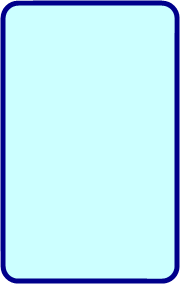
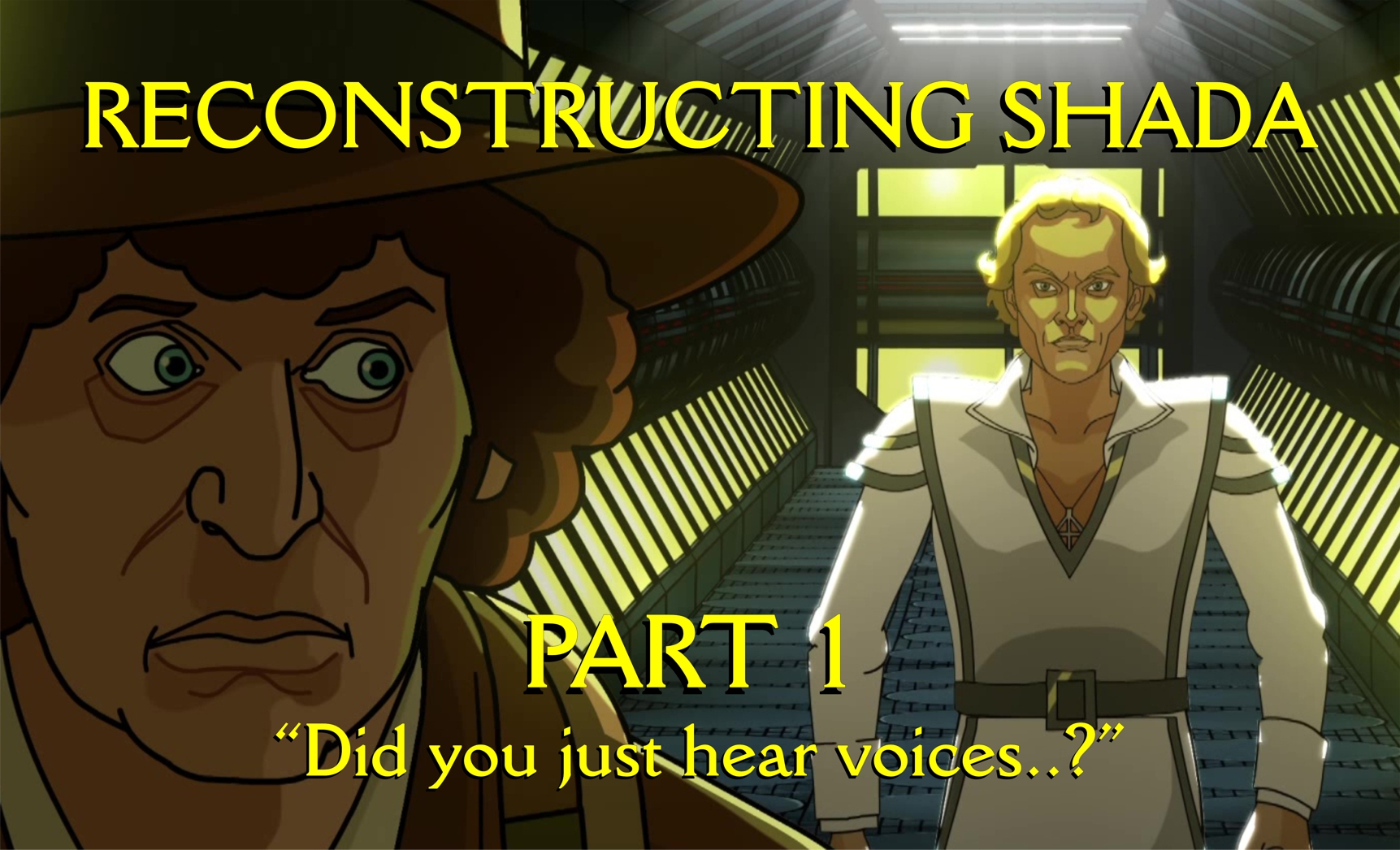
• CHARLES NORTON (Director):
That's Toby Hadoke voicing the continuity announcement at the start of the programme. It was recorded at Audio Sorcery Studios on 9th June 2017. It was the last thing we recorded that day. Tom Baker had just finished and we recorded this shortly after he left us. Daniel Hill, Toby and myself were the last to leave the studio anyway, as we all had to catch the same train back. I originally scripted the announcement to be quite a bit longer. And it was that original longer announcement that Toby recorded. However, I later decided to trim it down in the final edit. The full announcement (as recorded) was as follows: "...and Angela Rippon will return with the news bulletin at 9:30. We're off to the oil fields of Dallas in two hours. But first, on BBC1, a little later than originally billed, we rejoin the TARDIS for another adventure in time and space, with Doctor Who." Incidentally, Toby's continuity announcement was only ever included in the full feature-length presentation of the story that you'll find on DVD and Blu-Ray. It was omitted from the edit of Shada that was broadcast on BBC America on 18th July 2018. (NOTE: Even though Toby had his part cut from the BBC America transmission, he was still listed on the end credits for that broadcast. The credits remained identical to the unedited UK master.)
For Polyband's June 2022 German release of Shada, Toby re-recorded his opening announcement on 4th April 2022 - "Und nun auf BBC1: Etwas später als angekündigt, begleiten wir wieder einmal die Tardis auf einem neuen Abenteuer durch Raum und Zeit mit Doctor Who."

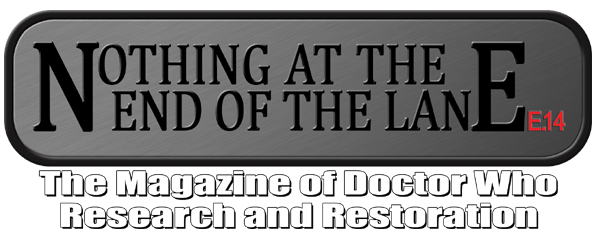
All timings in this article are taken from the 2017 master file for Shada. Whether you are watching the original 2017 DVD/BluRay; the 2021 Season 17 Blu-ray Collection box-set re-issue or the German-dubbed Polyband DVD/BluRay, the timings should still all match those cited here. It doesn't matter which edition you watch, as they should all use the same edit of the production. Of course, if you're watching the alternate 6-part special feature on the 2021 box-set or if you're watching the 1992 VHS compilation, then the timings won't match. So, if you are reading these viewing notes as you watch, make sure you're playing the right disc.
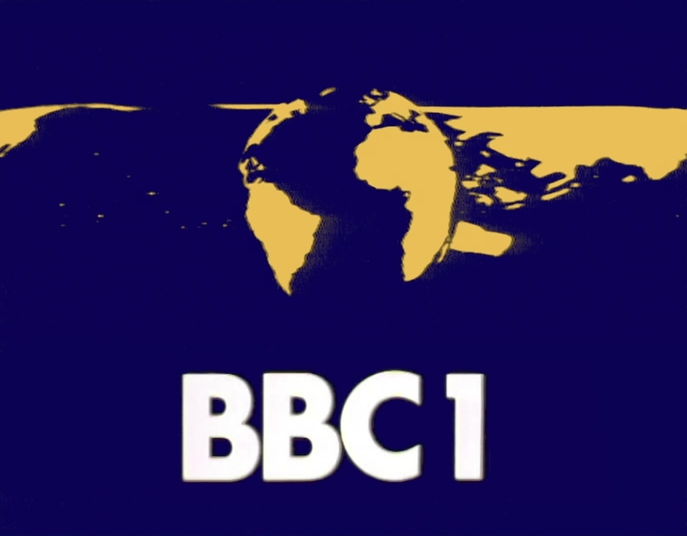
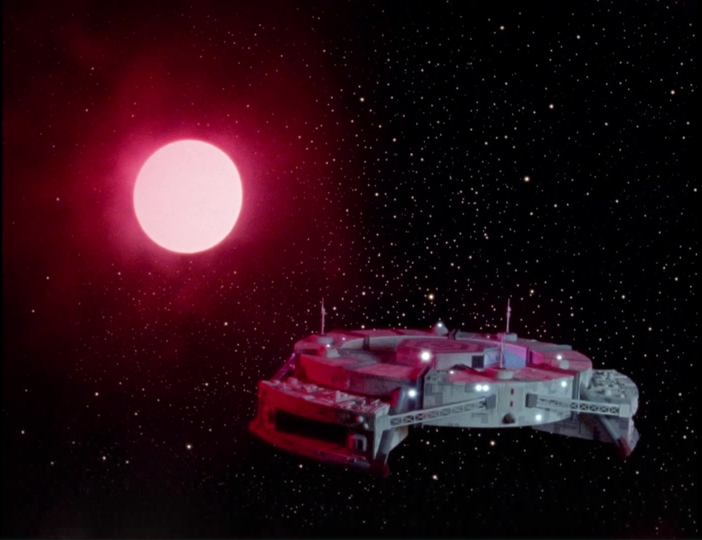
0:00:12 - Think Tank Space Station - Establishing Shot
• CHARLES NORTON:
The first shot of the programme. This was filmed on our first visual effects day, over on the sound stage at Halliford Studios in Shepperton. A lovely old film studio, Halliford actually closed down just a few months after we filmed with them. We were one of the very last productions in there. It had a venerable history. The studio was especially busy in 1970s, when it was used to film TV shows like Catweazle (1970/1) and films like The Riddle of the Sands (1979). Doctor Who had previously shot at Halliford too. Both Cold War (2012) and The Time of the Doctor (2013) filmed there.
The model of the Think Tank was built by Mike Tucker and his Model Unit, based on the design of an original (now lost) model built by the BBC Visual Effects Department back in 1979.
• MIKE TUCKER (Visual Effects Supervisor):
At the end of 2016 we were contacted by Charles Norton, who been the producer of the animated version of the lost Patrick Troughton story The Power of the Daleks the previous year. Having secured the involvement of Tom Baker to reprise his role as the fourth Doctor, Charles was in the early stages of planning a new version of Shada, using the same animation techniques to complete the missing sections of the story. But he also had other ambitions.
Charles was very conscious of the fact that the transition between the existing live action and the new animated footage could potentially be very jarring, and wanted to avoid situations where he was cutting between the two versions for only one or two shots. With the early parts of the story virtually complete other than for a few missing model shots, Charles wanted us to provide those missing shots using traditional ‘in camera’ miniature effects techniques - shooting in exactly the same way as the effects crew would have done back in 1979 - and allowing his animation team to concentrate on the largely incomplete second half of the story.
The missing sequences primarily concerned the Think Tank space station and Skagra’s spacecraft, with additional shots needing models of both the Doctor’s and Professor Chronotis’ TARDISes. In order to ensure that the new model shots were as authentic as possible, care needed to be taken to match the look of the original filming miniatures. To that end I contacted VFX Assistant Steve Cambden, who had been the K-9 operator on the original show, and who had taken a number of photographs of the original models, both in the BBC VFX workshop, and on set at Television Centre. Steve’s photos were clear enough to identify individual kit parts used in the construction of the miniatures, allowing the Model Unit’s new versions to be as close to the 1979 versions as possible.
The trick with the models was not to try and update them, or to use any techniques or materials that would be out of keeping with what was possible for Dave Havard and his team at the effects department in the late 70s. We were lucky in that a lot of the kits that had been used in the construction of the originals were still available in reissued form, and the Think Tank in particular makes a lot of use of Space 1999 Eagle Transporter kit parts, and components from the much-loved Airfix Girder Bridge. Taking measurements from those parts allowed us to work out the size of the original models.
Model filming took place at Halliford Studios on the 8th and 9th of September 2017, with Model Unit regular Peter Tyler acting as DoP. In order to ensure a suitably period look that would cut seamlessly with the rest of the production, the shoot was on 16mm film and the shots were achieved ‘in camera’, with the spacecraft hung on steel line in front of a backlit star field.
• CHARLES NORTON:
The starry background behind the model is a large sheet of black card with tiny holes punched in it. Bright lights behind the card shine through those holes, to create the impression of stars. The sun is created in a similar way, but that's a much bigger hole, with coloured lighting gels used to give it a more fiery hue.
• MIKE TUCKER:
The morning of first day of the shoot was predominantly spent rigging the star field and shooting the establishing shots of the Think Tank space station. The afternoon was given over to shots of the TARDIS travelling through space.
• CHARLES NORTON:
The model Think Tank in the foreground is hanging from wires. However, those wires are not above the model, as you might expect, but below it. The entire scene was filmed upside down. This is an old Thunderbirds technique. The logic being that when a model is hanging from wires, the viewer will always look for those wires above the model. If the model is hanging upside-down, then the wires are actually underneath and the viewer is less likely to spot them. As long as you also have the camera upside-down, then the whole thing will look the right way up when you watch the completed footage back. And even if not, you can always flip the shot the right way up afterwards in post-production.
The whole of this sequence (and all of the miniature effects work we did on Shada) was shot on 16mm colour film, just as it would have been in the late 1970s. We used an Arri 16SR camera. This is a film camera that was used quite a bit in the late 1970s. It was first introduced onto the market in 1975, superseding the earlier 1965 Arri 16BL. It's a workhorse of the British television industry. The model we were using was from 1993. However, Arri carried on making them up until 2006. They've been used to film a lot of Doctor Who over the years - especially in the first half of the 1980s. The last Doctor Who episode (other than Shada) to shoot film on the Arri 16SR was the Matt Smith story, Cold War (2013). Back in 1979, we honestly don't know if the original Shada crew actually filmed with an Arri 16SR or not. However, it was certainly one of three cameras available to the BBC at the time. The other two cameras being the Arri 16BL and the Eclair NPR. And one of these three would have been used to have captured all of the location filming on Shada.
The director of photography on our two-day visual effects shoot was Peter Tyler. The focus puller was Chris Hayden. Alan Graham was the gaffer, with Mickey Reeves as the sparks.
The first shot of the programme. This was filmed on our first visual effects day, over on the sound stage at Halliford Studios in Shepperton. A lovely old film studio, Halliford actually closed down just a few months after we filmed with them. We were one of the very last productions in there. It had a venerable history. The studio was especially busy in 1970s, when it was used to film TV shows like Catweazle (1970/1) and films like The Riddle of the Sands (1979). Doctor Who had previously shot at Halliford too. Both Cold War (2012) and The Time of the Doctor (2013) filmed there.
The model of the Think Tank was built by Mike Tucker and his Model Unit, based on the design of an original (now lost) model built by the BBC Visual Effects Department back in 1979.
• MIKE TUCKER (Visual Effects Supervisor):
At the end of 2016 we were contacted by Charles Norton, who been the producer of the animated version of the lost Patrick Troughton story The Power of the Daleks the previous year. Having secured the involvement of Tom Baker to reprise his role as the fourth Doctor, Charles was in the early stages of planning a new version of Shada, using the same animation techniques to complete the missing sections of the story. But he also had other ambitions.
Charles was very conscious of the fact that the transition between the existing live action and the new animated footage could potentially be very jarring, and wanted to avoid situations where he was cutting between the two versions for only one or two shots. With the early parts of the story virtually complete other than for a few missing model shots, Charles wanted us to provide those missing shots using traditional ‘in camera’ miniature effects techniques - shooting in exactly the same way as the effects crew would have done back in 1979 - and allowing his animation team to concentrate on the largely incomplete second half of the story.
The missing sequences primarily concerned the Think Tank space station and Skagra’s spacecraft, with additional shots needing models of both the Doctor’s and Professor Chronotis’ TARDISes. In order to ensure that the new model shots were as authentic as possible, care needed to be taken to match the look of the original filming miniatures. To that end I contacted VFX Assistant Steve Cambden, who had been the K-9 operator on the original show, and who had taken a number of photographs of the original models, both in the BBC VFX workshop, and on set at Television Centre. Steve’s photos were clear enough to identify individual kit parts used in the construction of the miniatures, allowing the Model Unit’s new versions to be as close to the 1979 versions as possible.
The trick with the models was not to try and update them, or to use any techniques or materials that would be out of keeping with what was possible for Dave Havard and his team at the effects department in the late 70s. We were lucky in that a lot of the kits that had been used in the construction of the originals were still available in reissued form, and the Think Tank in particular makes a lot of use of Space 1999 Eagle Transporter kit parts, and components from the much-loved Airfix Girder Bridge. Taking measurements from those parts allowed us to work out the size of the original models.
Model filming took place at Halliford Studios on the 8th and 9th of September 2017, with Model Unit regular Peter Tyler acting as DoP. In order to ensure a suitably period look that would cut seamlessly with the rest of the production, the shoot was on 16mm film and the shots were achieved ‘in camera’, with the spacecraft hung on steel line in front of a backlit star field.
• CHARLES NORTON:
The starry background behind the model is a large sheet of black card with tiny holes punched in it. Bright lights behind the card shine through those holes, to create the impression of stars. The sun is created in a similar way, but that's a much bigger hole, with coloured lighting gels used to give it a more fiery hue.
• MIKE TUCKER:
The morning of first day of the shoot was predominantly spent rigging the star field and shooting the establishing shots of the Think Tank space station. The afternoon was given over to shots of the TARDIS travelling through space.
• CHARLES NORTON:
The model Think Tank in the foreground is hanging from wires. However, those wires are not above the model, as you might expect, but below it. The entire scene was filmed upside down. This is an old Thunderbirds technique. The logic being that when a model is hanging from wires, the viewer will always look for those wires above the model. If the model is hanging upside-down, then the wires are actually underneath and the viewer is less likely to spot them. As long as you also have the camera upside-down, then the whole thing will look the right way up when you watch the completed footage back. And even if not, you can always flip the shot the right way up afterwards in post-production.
The whole of this sequence (and all of the miniature effects work we did on Shada) was shot on 16mm colour film, just as it would have been in the late 1970s. We used an Arri 16SR camera. This is a film camera that was used quite a bit in the late 1970s. It was first introduced onto the market in 1975, superseding the earlier 1965 Arri 16BL. It's a workhorse of the British television industry. The model we were using was from 1993. However, Arri carried on making them up until 2006. They've been used to film a lot of Doctor Who over the years - especially in the first half of the 1980s. The last Doctor Who episode (other than Shada) to shoot film on the Arri 16SR was the Matt Smith story, Cold War (2013). Back in 1979, we honestly don't know if the original Shada crew actually filmed with an Arri 16SR or not. However, it was certainly one of three cameras available to the BBC at the time. The other two cameras being the Arri 16BL and the Eclair NPR. And one of these three would have been used to have captured all of the location filming on Shada.
The director of photography on our two-day visual effects shoot was Peter Tyler. The focus puller was Chris Hayden. Alan Graham was the gaffer, with Mickey Reeves as the sparks.
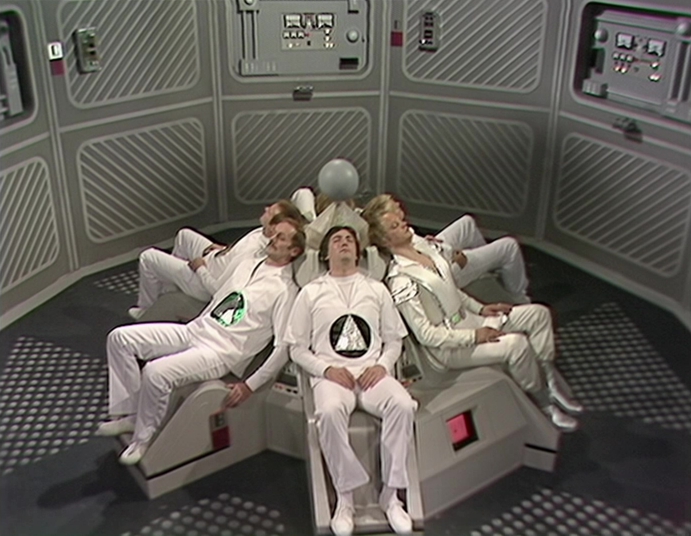
• CHARLES NORTON:
And now we cut to our first piece of footage from the original 1979 production. The scene here was shot on 19th November 1979 in studio TC3 at BBC Television Centre. It was the first scene of the day to be completed.
And now we cut to our first piece of footage from the original 1979 production. The scene here was shot on 19th November 1979 in studio TC3 at BBC Television Centre. It was the first scene of the day to be completed.
0:00:30 - Skagra operates the brain drain machine
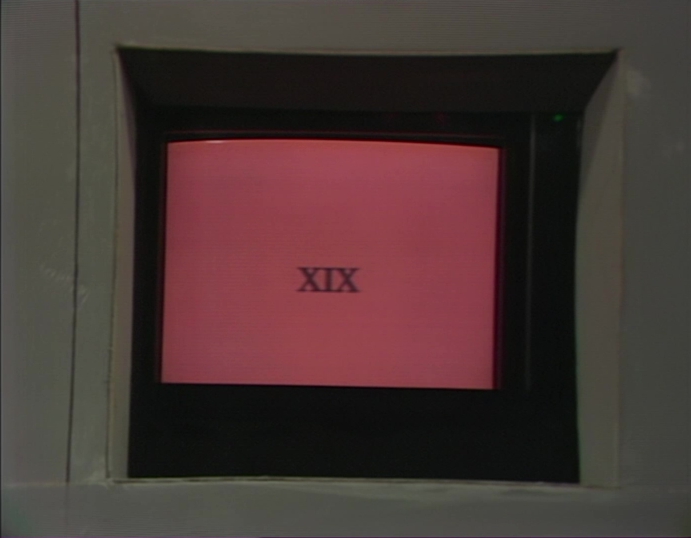
0:00:53 - Countdown Clock
• CHARLES NORTON:
I had hoped that we'd be able to replace these countdown graphics with some newly created ones. However, we ran out of time. Unable to improve upon it, my next thought was to remove the countdown clock altogether and I think I did a rough edit of this scene with all those cutaways removed. My thinking being that the countdown didn't really appear to represent anything meaningful or make any obvious narrative sense. And as the duration of the programme was massively over-running anyway, it didn't hurt to lose a few seconds. It was Mark Ayres who persuaded me I was wrong here and convinced me to put the countdown clock back into the edit. As he pointed out, yes, it didn't make any real story sense, but it's otherwise such a slow scene, the fake jeopardy of the countdown clock provides the only real sense of tension the scene has. So, we put it back in. And Mark was right, of course. When coupled with his music (and sound design) it really works so much better in context, than when just viewed cold.
I had hoped that we'd be able to replace these countdown graphics with some newly created ones. However, we ran out of time. Unable to improve upon it, my next thought was to remove the countdown clock altogether and I think I did a rough edit of this scene with all those cutaways removed. My thinking being that the countdown didn't really appear to represent anything meaningful or make any obvious narrative sense. And as the duration of the programme was massively over-running anyway, it didn't hurt to lose a few seconds. It was Mark Ayres who persuaded me I was wrong here and convinced me to put the countdown clock back into the edit. As he pointed out, yes, it didn't make any real story sense, but it's otherwise such a slow scene, the fake jeopardy of the countdown clock provides the only real sense of tension the scene has. So, we put it back in. And Mark was right, of course. When coupled with his music (and sound design) it really works so much better in context, than when just viewed cold.
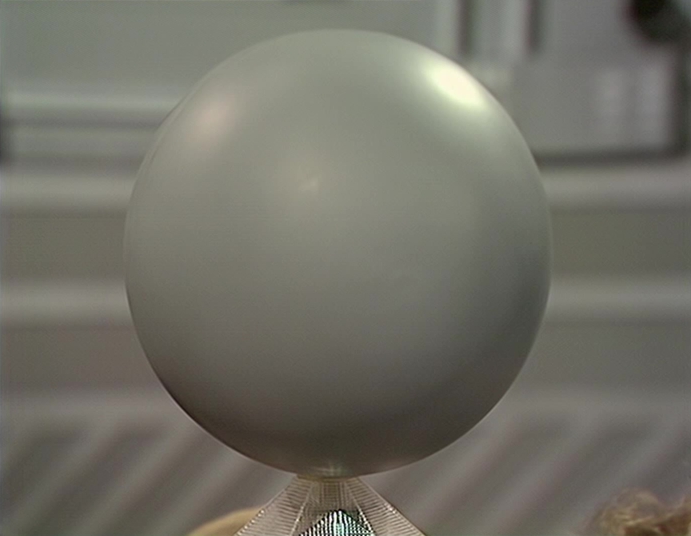
0:01:50 - The Sphere Babble
• CHARLES NORTON:
The 'babble' you hear coming from the sphere is one of a number of special sound effects in this story that were originally created by Dick Mills over at the BBC Radiophonic Workshop. However, they weren't created in 1979, as part of Shada's original production. And they weren't created in 2017, as part of Shada's final production block. Mills had been assigned to complete sound effects work for Shada back in 1979. However, production was shut down before he had a chance to make a start on it. Later though, in 1992, a compilation of completed Shada footage was put together for BBC Video and it was at this time that Mills was brought back in to finally produce special sound effects for the story. It was in fact, the last Doctor Who story on which Dick Mills would work (following over 30 years association with the programme). And it is these 1992 sound effects that were used in the final production of Shada, when it was completed in 2017. Plus, of course, a whole load of new ones created by Mark Ayres.
• MARK AYRES (Music and Sound Design):
Yes, I created some new sounds for this story, including a new 'babble' that sounded a bit more like voices trapped in a bag. Mainly, though, for Skagra’s Shuttle, the Krarg Control Ship, and Shada itself which did not appear in the 1992 “work in progress” edit. The new Shada sounds were all based on “Time Lord Court” sounds from The War Games.
The 'babble' you hear coming from the sphere is one of a number of special sound effects in this story that were originally created by Dick Mills over at the BBC Radiophonic Workshop. However, they weren't created in 1979, as part of Shada's original production. And they weren't created in 2017, as part of Shada's final production block. Mills had been assigned to complete sound effects work for Shada back in 1979. However, production was shut down before he had a chance to make a start on it. Later though, in 1992, a compilation of completed Shada footage was put together for BBC Video and it was at this time that Mills was brought back in to finally produce special sound effects for the story. It was in fact, the last Doctor Who story on which Dick Mills would work (following over 30 years association with the programme). And it is these 1992 sound effects that were used in the final production of Shada, when it was completed in 2017. Plus, of course, a whole load of new ones created by Mark Ayres.
• MARK AYRES (Music and Sound Design):
Yes, I created some new sounds for this story, including a new 'babble' that sounded a bit more like voices trapped in a bag. Mainly, though, for Skagra’s Shuttle, the Krarg Control Ship, and Shada itself which did not appear in the 1992 “work in progress” edit. The new Shada sounds were all based on “Time Lord Court” sounds from The War Games.
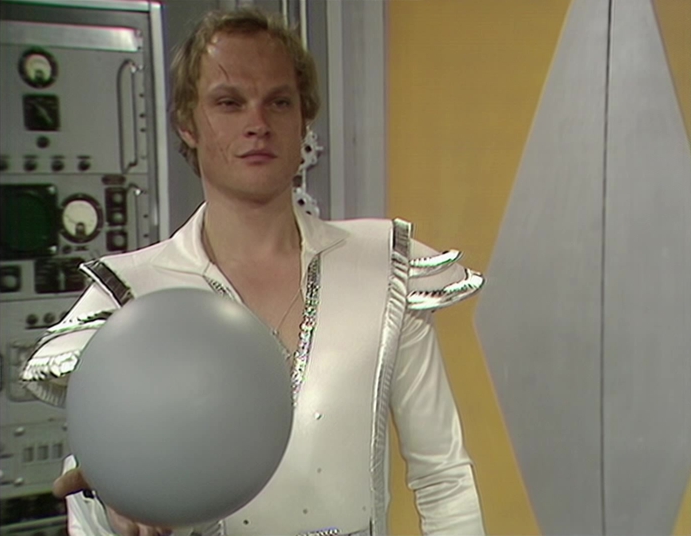
0:02:30 - Think Tank Recorded Message
• CHARLES NORTON:
The recorded message that you can hear playing over this scene was originally scripted to be the voice of Skagra. The original production team's intention, back in 1979, was that the voice-over would be recorded by Christopher Neame that December, during either the production's second or third studio recording block at BBC Television Centre. Except of course, production got shut down early at the end of November. And so, Neame never got a chance to record that audio. In 1992, when BBC Video put out a compilation of footage from Shada for the domestic home video market, they brought in David Brierley (who also voices K9) to record the audio message, instead of Neame.
When production on Shada finally resumed in 2017, we naturally had the option of re-recording the scene as originally intended, with Chris Neame voicing the audio. However, I really rather liked David Brierley's delivery of the Think Tank computer voice and so decided to just use the tape of that made in 1992, even though it went against the originally scripted intention of that scene. Besides, I felt that the drama worked rather better if we saved up Skagra's first spoken words until later on in the narrative and made a bit more of them being his first words, rather than just throwing that moment away early here. As David Brierley had died in 2008, I was also keen to retain as much pre-existing material we had from him as we practically could. Especially as this was the last Doctor Who episode on which he ever worked.
The recorded message that you can hear playing over this scene was originally scripted to be the voice of Skagra. The original production team's intention, back in 1979, was that the voice-over would be recorded by Christopher Neame that December, during either the production's second or third studio recording block at BBC Television Centre. Except of course, production got shut down early at the end of November. And so, Neame never got a chance to record that audio. In 1992, when BBC Video put out a compilation of footage from Shada for the domestic home video market, they brought in David Brierley (who also voices K9) to record the audio message, instead of Neame.
When production on Shada finally resumed in 2017, we naturally had the option of re-recording the scene as originally intended, with Chris Neame voicing the audio. However, I really rather liked David Brierley's delivery of the Think Tank computer voice and so decided to just use the tape of that made in 1992, even though it went against the originally scripted intention of that scene. Besides, I felt that the drama worked rather better if we saved up Skagra's first spoken words until later on in the narrative and made a bit more of them being his first words, rather than just throwing that moment away early here. As David Brierley had died in 2008, I was also keen to retain as much pre-existing material we had from him as we practically could. Especially as this was the last Doctor Who episode on which he ever worked.
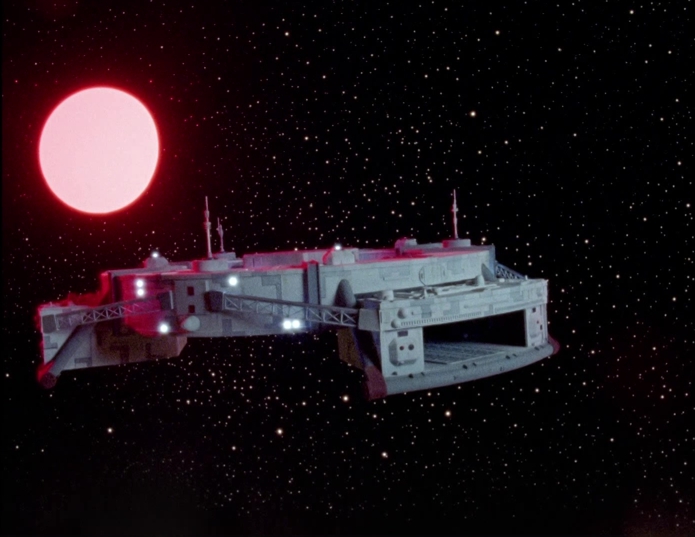
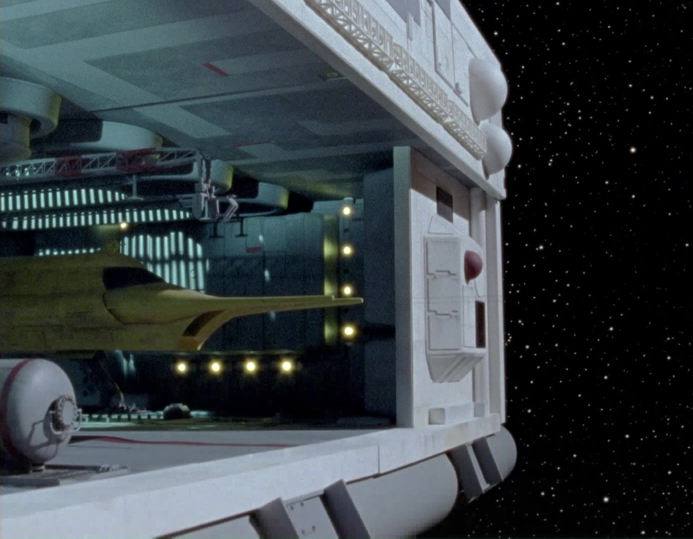
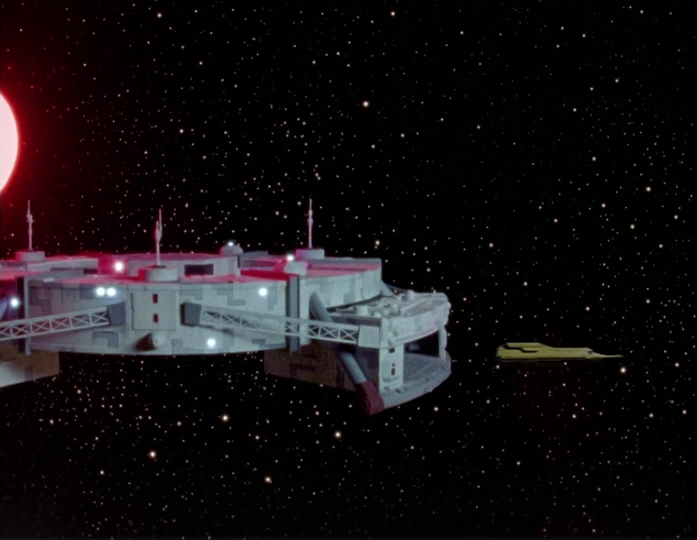
0:03:30 - Skagra's Ship Exits Think Tank
• CHARLES NORTON:
Another of the model sequences we completed at Halliford studios - and it's probably the single most complex sequence we did there.
• MIKE TUCKER:
Although the original intention had been to film the explosive destruction of the Think Tank as part of the new model shoot, Charles discovered that the original footage (one of the only original model shots that had been completed) still existed in the BBC archive, and so the money allocated to that shot was diverted instead to a model that had never made it as far as construction for the 1979 production.
In the script, Skagra makes his way to the shuttle bay, and then there is a direction for the shuttlecraft to be seen leaving the hanger. It seemed logical to assume that there would have been a close up of the ship leaving the space station before cutting to a wide shot - and indeed, it does seem that Dave Havard had drawn some initial sketches of a possible shuttle bay design before it was presumably cut for budget reasons. It seemed like too good an opportunity not to reinstate that shot, and so a miniature was built in scale with Skagra’s spacecraft using construction techniques that were sympathetic in feel to similar shots from other Doctor Who episodes from that era.
Another of the model sequences we completed at Halliford studios - and it's probably the single most complex sequence we did there.
• MIKE TUCKER:
Although the original intention had been to film the explosive destruction of the Think Tank as part of the new model shoot, Charles discovered that the original footage (one of the only original model shots that had been completed) still existed in the BBC archive, and so the money allocated to that shot was diverted instead to a model that had never made it as far as construction for the 1979 production.
In the script, Skagra makes his way to the shuttle bay, and then there is a direction for the shuttlecraft to be seen leaving the hanger. It seemed logical to assume that there would have been a close up of the ship leaving the space station before cutting to a wide shot - and indeed, it does seem that Dave Havard had drawn some initial sketches of a possible shuttle bay design before it was presumably cut for budget reasons. It seemed like too good an opportunity not to reinstate that shot, and so a miniature was built in scale with Skagra’s spacecraft using construction techniques that were sympathetic in feel to similar shots from other Doctor Who episodes from that era.
• CHARLES NORTON:
There's two parts to what you see here. The main Think Tank model is just as previously described, but Skagra's ship is an entirely separate model built at a completely different scale to the Think Tank. In fact, the model of Skagra's spaceship is roughly the same length as the total diameter of the Think Tank model. So, how does one fit inside the other? Well, obviously, it doesn't. Mike built a much larger model of just the hangar bay interior of the Think Tank, at a scale many times larger than the rest of the model. And it is that model hangar bay inside which the model of Skagra's ship (also built by Mike, based on an original 1979 design) sits. Except, it isn't really 'sitting' there.
The whole model is actually rotated 90 degrees on its side and Skagra's ship is suspended vertically from the ceiling on a length of wire. The wire is pulled via a pulley system upwards and the ship emerges out of the top of the hangar (which appears to be its side, because the camera is also rotated 90 degrees). As the Think Tank is meant to be moving, the stars have to be put in later as a separate piece of footage, with the stars moving from one side to the other. However, that's a simple composit, as it's against black anyway. For the wide shot of the ship moving off into space, we filmed the same Skagra ship miniature against a green screen and then superimposed that footage (at a much reduced scale) against separately filmed footage of the main Think Tank miniature, shot against our starry background from earlier.
There's two parts to what you see here. The main Think Tank model is just as previously described, but Skagra's ship is an entirely separate model built at a completely different scale to the Think Tank. In fact, the model of Skagra's spaceship is roughly the same length as the total diameter of the Think Tank model. So, how does one fit inside the other? Well, obviously, it doesn't. Mike built a much larger model of just the hangar bay interior of the Think Tank, at a scale many times larger than the rest of the model. And it is that model hangar bay inside which the model of Skagra's ship (also built by Mike, based on an original 1979 design) sits. Except, it isn't really 'sitting' there.
The whole model is actually rotated 90 degrees on its side and Skagra's ship is suspended vertically from the ceiling on a length of wire. The wire is pulled via a pulley system upwards and the ship emerges out of the top of the hangar (which appears to be its side, because the camera is also rotated 90 degrees). As the Think Tank is meant to be moving, the stars have to be put in later as a separate piece of footage, with the stars moving from one side to the other. However, that's a simple composit, as it's against black anyway. For the wide shot of the ship moving off into space, we filmed the same Skagra ship miniature against a green screen and then superimposed that footage (at a much reduced scale) against separately filmed footage of the main Think Tank miniature, shot against our starry background from earlier.
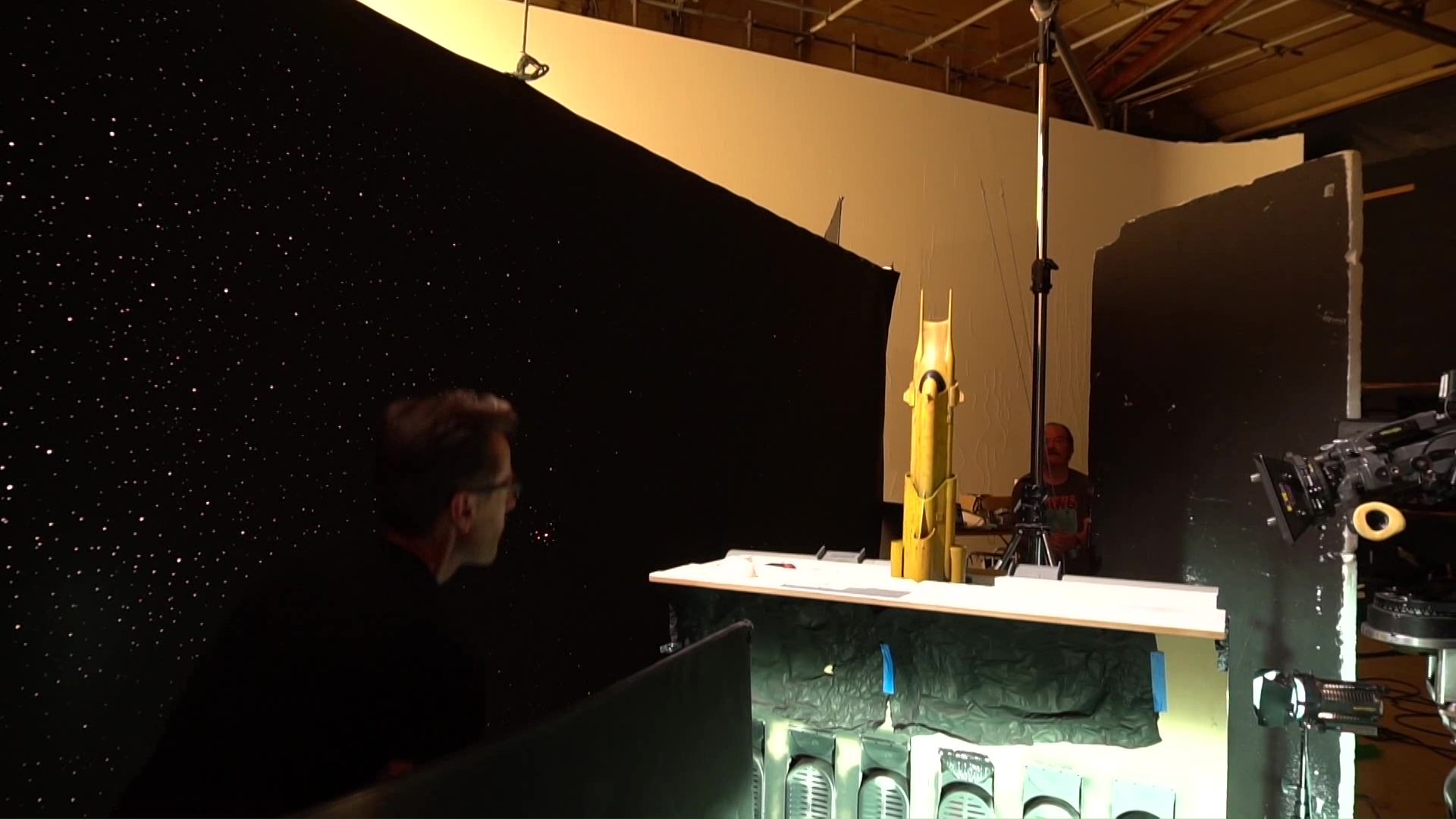
• MARK AYRES:
On the original [2017] release of Shada, two later shots comp’d in “still” stars rather than “moving” ones. This has been corrected on the 2021 Season 17 Collection release. As has the aspect ratio (which was a tad too thin in 2017) and some of the grading.
• MIKE TUCKER:
Skagra’s ship was constructed from EMA tubing and plasticard sheet, with detailing from a number of vintage tank kits that I had in my stock of materials. The only concession that we made to new technology was in the use of LEDs as light sources, rather than incandescent bulbs, and that allowed us to keep the battery weight down.
The final set up revolved around the close up section of the Think Tank hanger, which was rigged standing on end so that Skagra's spacecraft miniature could be pulled vertically out through the hanger bay entrance.
• CHARLES NORTON:
Again, all this was of course, shot on 16mm film. It's worth saying here that although we don't know exactly how they would have attempted to achieve this scene in 1979, we do however know that they wouldn't have done it the way we did it. Everything we did was done using the kinds of technologies and techniques that were available to Doctor Who in 1979. Budgets were very tight in late 1979 and so the original Shada production team would probably have tried to pull off this sequence in a much less elaborate way than we did, using electronic video cameras, vision mixing, CSO and maybe some early digital video effects. How would it have looked? Probably a bit awful, if we're honest, which is one of the reasons we didn't do it like that.
As with lots of other things in Shada, our approach was to try and use only the techniques that would have existed in 1979, but we didn't restrict ourselves to only those techniques that would have been possible on the budget they had available in 1979. Had Graham Williams allowed the visual effects team to create the effect we did back in 1979, he'd probably have run out of money to complete the rest of the season. However, he could have done it. It was technically possible. And so, there's nothing we've done here that's anachronistic to the period. If we had been trying to create a reconstruction of exactly what they did in 1979, it would have been different of course. However, Shada was never about that for us. In 2017, it was only ever about picking up where they'd left off in 1979 and then making our own creative decisions about where we took it from there.
On the original [2017] release of Shada, two later shots comp’d in “still” stars rather than “moving” ones. This has been corrected on the 2021 Season 17 Collection release. As has the aspect ratio (which was a tad too thin in 2017) and some of the grading.
• MIKE TUCKER:
Skagra’s ship was constructed from EMA tubing and plasticard sheet, with detailing from a number of vintage tank kits that I had in my stock of materials. The only concession that we made to new technology was in the use of LEDs as light sources, rather than incandescent bulbs, and that allowed us to keep the battery weight down.
The final set up revolved around the close up section of the Think Tank hanger, which was rigged standing on end so that Skagra's spacecraft miniature could be pulled vertically out through the hanger bay entrance.
• CHARLES NORTON:
Again, all this was of course, shot on 16mm film. It's worth saying here that although we don't know exactly how they would have attempted to achieve this scene in 1979, we do however know that they wouldn't have done it the way we did it. Everything we did was done using the kinds of technologies and techniques that were available to Doctor Who in 1979. Budgets were very tight in late 1979 and so the original Shada production team would probably have tried to pull off this sequence in a much less elaborate way than we did, using electronic video cameras, vision mixing, CSO and maybe some early digital video effects. How would it have looked? Probably a bit awful, if we're honest, which is one of the reasons we didn't do it like that.
As with lots of other things in Shada, our approach was to try and use only the techniques that would have existed in 1979, but we didn't restrict ourselves to only those techniques that would have been possible on the budget they had available in 1979. Had Graham Williams allowed the visual effects team to create the effect we did back in 1979, he'd probably have run out of money to complete the rest of the season. However, he could have done it. It was technically possible. And so, there's nothing we've done here that's anachronistic to the period. If we had been trying to create a reconstruction of exactly what they did in 1979, it would have been different of course. However, Shada was never about that for us. In 2017, it was only ever about picking up where they'd left off in 1979 and then making our own creative decisions about where we took it from there.
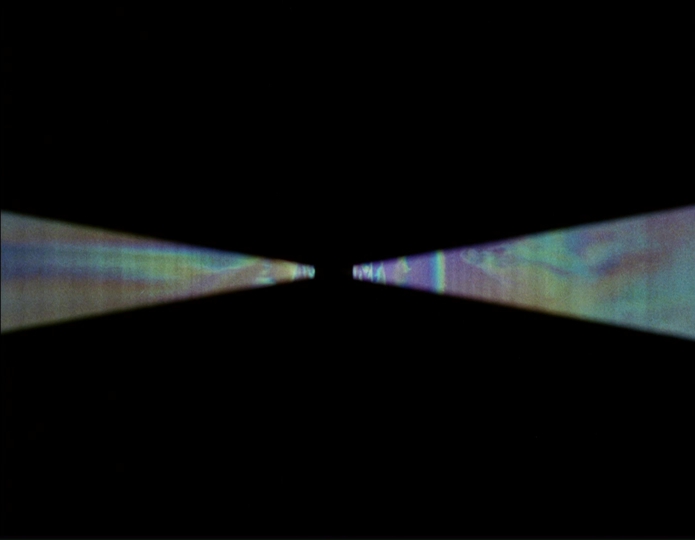
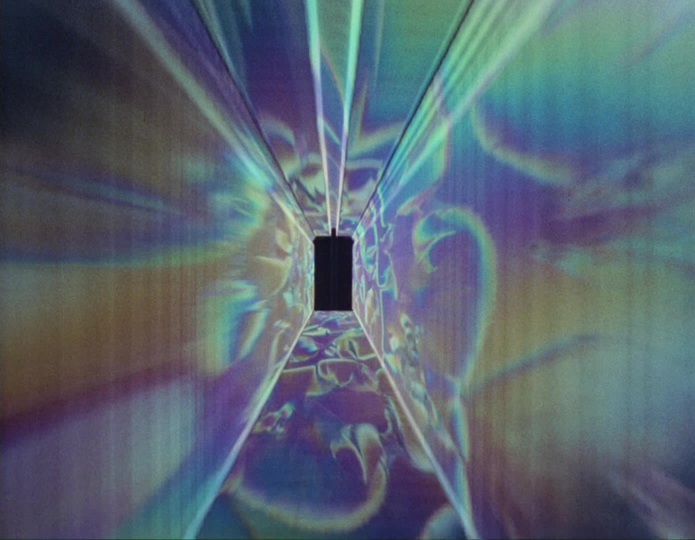
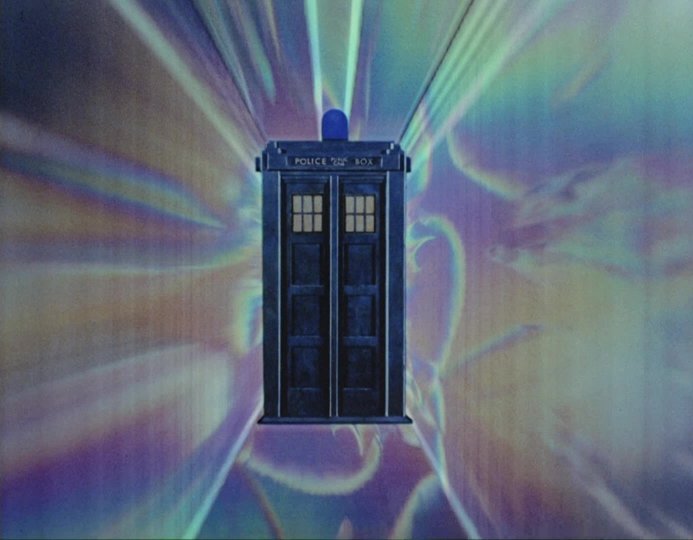
0:03:39 - Pre-Titles Sequence
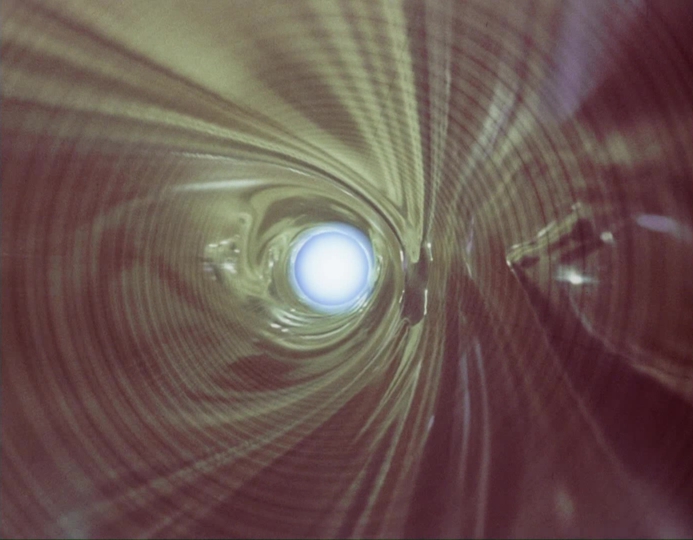
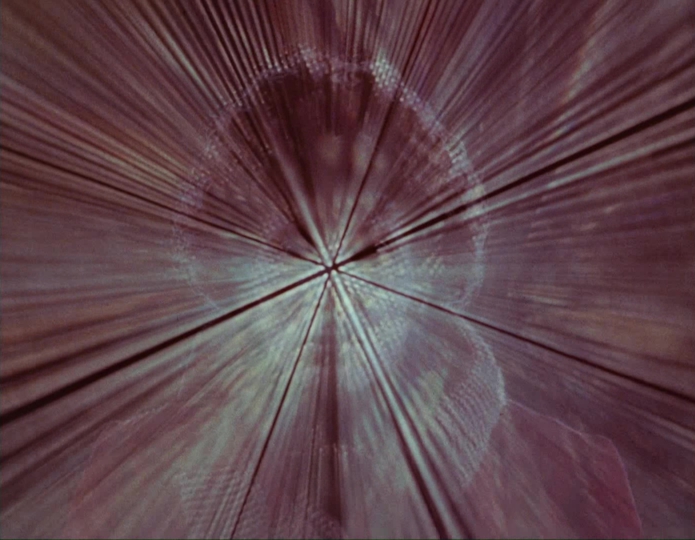
• CHARLES NORTON:
With Shada, I moved the title sequence to come after the first scene and not before it. This, of course creates a pre-title sequence. It was quite a last minute decision, actually. Why did we do this? Well, it just felt like a nice way to start the story and make it feel a bit special. Nothing more than that really. Pre-title sequences were very common in 1970s TV shows - especially on the kind of escapist adventure show that Doctor Who was. However, for some reason, Doctor Who never itself actually used the device on any 1970s episode. Even in the 1980s, there's only three episodes with pre-title sequences (on 1982's Castrovalva, 1983's The Five Doctors and 1988's Remembrance of the Daleks). However, in 2017, we were now working on Shada in a very different context to the one the original production team had back in 1979. We were now completing Shada as a one-off television special, and not just the next instalment in a wider season of episodes. And if you were completing Shada as a one-off special in 1979 (or 1981, as was also once planned), I think you can well imagine wanting to put a pre-title sequence on the front. It feels like exactly the kind of thing producer John Nathan-Turner might have done for a Christmas special. Just to make it stand out.
And besides, the pre-title sequence is such an extremely 1979-1981 kind of thing to do. So it felt right on those terms too. You see it a lot around this time on shows like The Professionals, The New Avengers, The Day of the Triffids and The Hitch Hiker's Guide to the Galaxy. With Shada set to be broadcast as a TV special, the pre-title just felt like a nice way of making it feel... well... special.
• MARK AYRES:
Making this a pre-title sequence was a decision made quite late in the day and the music had already been scored, so it needed a slight edit in the sound dub to fit. The six-part version Shada on the Season 17 Collection restores the opening to how it was originally scripted and scored. i.e. we start with the titles!
With Shada, I moved the title sequence to come after the first scene and not before it. This, of course creates a pre-title sequence. It was quite a last minute decision, actually. Why did we do this? Well, it just felt like a nice way to start the story and make it feel a bit special. Nothing more than that really. Pre-title sequences were very common in 1970s TV shows - especially on the kind of escapist adventure show that Doctor Who was. However, for some reason, Doctor Who never itself actually used the device on any 1970s episode. Even in the 1980s, there's only three episodes with pre-title sequences (on 1982's Castrovalva, 1983's The Five Doctors and 1988's Remembrance of the Daleks). However, in 2017, we were now working on Shada in a very different context to the one the original production team had back in 1979. We were now completing Shada as a one-off television special, and not just the next instalment in a wider season of episodes. And if you were completing Shada as a one-off special in 1979 (or 1981, as was also once planned), I think you can well imagine wanting to put a pre-title sequence on the front. It feels like exactly the kind of thing producer John Nathan-Turner might have done for a Christmas special. Just to make it stand out.
And besides, the pre-title sequence is such an extremely 1979-1981 kind of thing to do. So it felt right on those terms too. You see it a lot around this time on shows like The Professionals, The New Avengers, The Day of the Triffids and The Hitch Hiker's Guide to the Galaxy. With Shada set to be broadcast as a TV special, the pre-title just felt like a nice way of making it feel... well... special.
• MARK AYRES:
Making this a pre-title sequence was a decision made quite late in the day and the music had already been scored, so it needed a slight edit in the sound dub to fit. The six-part version Shada on the Season 17 Collection restores the opening to how it was originally scripted and scored. i.e. we start with the titles!
0:03:39 - The Title Sequence
• CHARLES NORTON:
The title sequence as you see it on Shada is from a completely new 2K scan of the original 1974 35mm camera negatives. The film was scanned on a Scanity HDR film scanner at the R3Store facilities house in Poplar on 29th August 2017. All the 16mm film from the 1979 shoot of Shada and all of the 16mm film from our 2017 model shoot were also scanned that day. Cleaned up by the Restoration Team's Peter Crocker and converted down to 1080p HD resolution, it was our transfer of the title sequence that was later used in the remastering of the Doctor Who - The Collection Season 12 and Season 14 box-sets in 2018 and 2019.
A German language version of the opening title sequence was also prepared some time later, so that it could be used for any German dubbed releases and broadcasts. This German opening title sequence is the same as the English version, except that the writer's caption reads 'Von Douglas Adams' instead of 'By Douglas Adams'.
The title sequence as you see it on Shada is from a completely new 2K scan of the original 1974 35mm camera negatives. The film was scanned on a Scanity HDR film scanner at the R3Store facilities house in Poplar on 29th August 2017. All the 16mm film from the 1979 shoot of Shada and all of the 16mm film from our 2017 model shoot were also scanned that day. Cleaned up by the Restoration Team's Peter Crocker and converted down to 1080p HD resolution, it was our transfer of the title sequence that was later used in the remastering of the Doctor Who - The Collection Season 12 and Season 14 box-sets in 2018 and 2019.
A German language version of the opening title sequence was also prepared some time later, so that it could be used for any German dubbed releases and broadcasts. This German opening title sequence is the same as the English version, except that the writer's caption reads 'Von Douglas Adams' instead of 'By Douglas Adams'.
0:03:39 - The Title Music
• CHARLES NORTON:
Okay, a very frequently asked question here, so, it's probably worth clearing up. "Why does the title music sound wrong?" Okay. Well, firstly, it's not wrong. I suspect that (for a lot of viewers) the title music sounds 'wrong'. However, that's just because you're watching your DVD or Blu-ray with the 5.1 surround sound mix selected on your machine. If you go to your menu screen and select either mono or stereo from the audio options, you'll get the original 1970s sound mix of the theme music - which I suspect is the version you probably wanted. The more salient question, of course, is why is the 5.1 mix the default sound option on this release, when the majority of consumers won't have any 5.1 equipment to play it on? Sorry, don't have the answer to that one! For some reason, that's just the way the authoring people did it. And besides, it really is a rather lovely 5.1 sound mix on Shada, so if you do have the correct 5.1 kit to play it properly, please give it a go. Mark Ayres did a marvellous job on it. And if you don't have a 5.1 set-up in your home (and let's face it, that's most of us), you always have the mono or stereo options to listen to instead. Which Mark also did a very fine job of.
• MARK AYRES:
No, the music is not “wrong”. It’s different, and quite deliberately so. Way back in 2002-3 I did a whole load of remixes of the Doctor Who theme, based on the very many original versions, in stereo and 5.1 surround. They are in fact rather more closely based on Delia Derbyshire’s original make-up tapes than the heavily edited and overdubbed 1970/1 titles, for which Delia worked from her 1963 mixed mono tapes, not from the make-up. I first used the 2003 opening titles mix on the 5.1 surround mix made for the DVD of Terror of the Zygons, but at the last moment, I decided to open with the original 1970 mono mix and “bloom” into 5.1 when the melody came in. And this is the version I used on all Jon Pertwee and Tom Baker 5.1 mixes up to Shada (and on some since). But for Shada itself, I decided to use my 2003 mix with its new surround intro as something a bit different for this special edition movie (though I left the original mono mix on the mono version of the film). While some were amused by this - as I had hoped they would be (and as I am sure my friend Delia would have been) - others were not. Indeed, I found myself being referred to in gynaecological terms on some of the darker corners of the internet, proving the adage that you cannot please all of the people all of the time. For the Season 17 Collection, I’ve left it as is on the remastered “movie”, but there is a new mix which closer replicates Delia’s original on the six-part edit. I suspect some folk still won’t be happy.
As to why the movie defaulted to 5.1 on the 2017 release, that’s because it’s essentially a new production, in HD, and 5.1 is the standard for HD where possible. The mono mix is there as a more “period authentic” alternative experience. The movie will still default to 5.1 on the Season 17 Collection, but the six-part edit will default to mono with 5.1 as the option.
Okay, a very frequently asked question here, so, it's probably worth clearing up. "Why does the title music sound wrong?" Okay. Well, firstly, it's not wrong. I suspect that (for a lot of viewers) the title music sounds 'wrong'. However, that's just because you're watching your DVD or Blu-ray with the 5.1 surround sound mix selected on your machine. If you go to your menu screen and select either mono or stereo from the audio options, you'll get the original 1970s sound mix of the theme music - which I suspect is the version you probably wanted. The more salient question, of course, is why is the 5.1 mix the default sound option on this release, when the majority of consumers won't have any 5.1 equipment to play it on? Sorry, don't have the answer to that one! For some reason, that's just the way the authoring people did it. And besides, it really is a rather lovely 5.1 sound mix on Shada, so if you do have the correct 5.1 kit to play it properly, please give it a go. Mark Ayres did a marvellous job on it. And if you don't have a 5.1 set-up in your home (and let's face it, that's most of us), you always have the mono or stereo options to listen to instead. Which Mark also did a very fine job of.
• MARK AYRES:
No, the music is not “wrong”. It’s different, and quite deliberately so. Way back in 2002-3 I did a whole load of remixes of the Doctor Who theme, based on the very many original versions, in stereo and 5.1 surround. They are in fact rather more closely based on Delia Derbyshire’s original make-up tapes than the heavily edited and overdubbed 1970/1 titles, for which Delia worked from her 1963 mixed mono tapes, not from the make-up. I first used the 2003 opening titles mix on the 5.1 surround mix made for the DVD of Terror of the Zygons, but at the last moment, I decided to open with the original 1970 mono mix and “bloom” into 5.1 when the melody came in. And this is the version I used on all Jon Pertwee and Tom Baker 5.1 mixes up to Shada (and on some since). But for Shada itself, I decided to use my 2003 mix with its new surround intro as something a bit different for this special edition movie (though I left the original mono mix on the mono version of the film). While some were amused by this - as I had hoped they would be (and as I am sure my friend Delia would have been) - others were not. Indeed, I found myself being referred to in gynaecological terms on some of the darker corners of the internet, proving the adage that you cannot please all of the people all of the time. For the Season 17 Collection, I’ve left it as is on the remastered “movie”, but there is a new mix which closer replicates Delia’s original on the six-part edit. I suspect some folk still won’t be happy.
As to why the movie defaulted to 5.1 on the 2017 release, that’s because it’s essentially a new production, in HD, and 5.1 is the standard for HD where possible. The mono mix is there as a more “period authentic” alternative experience. The movie will still default to 5.1 on the Season 17 Collection, but the six-part edit will default to mono with 5.1 as the option.
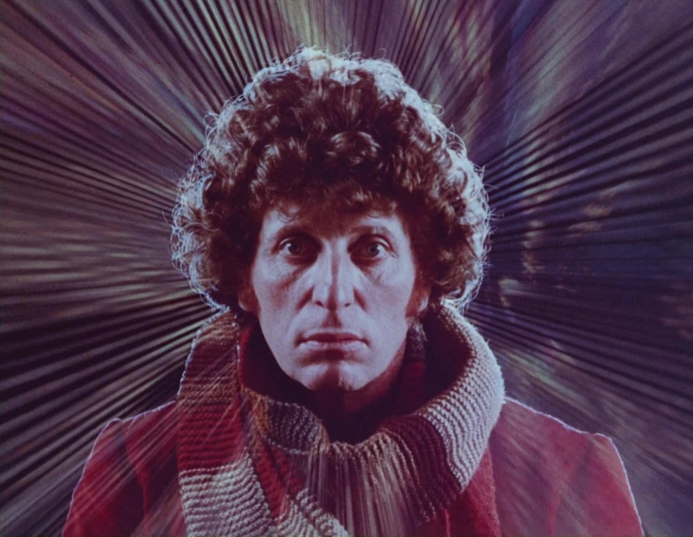
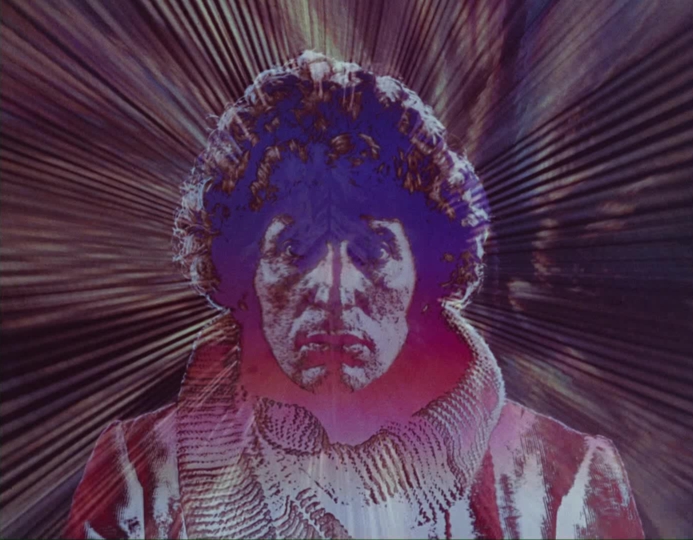
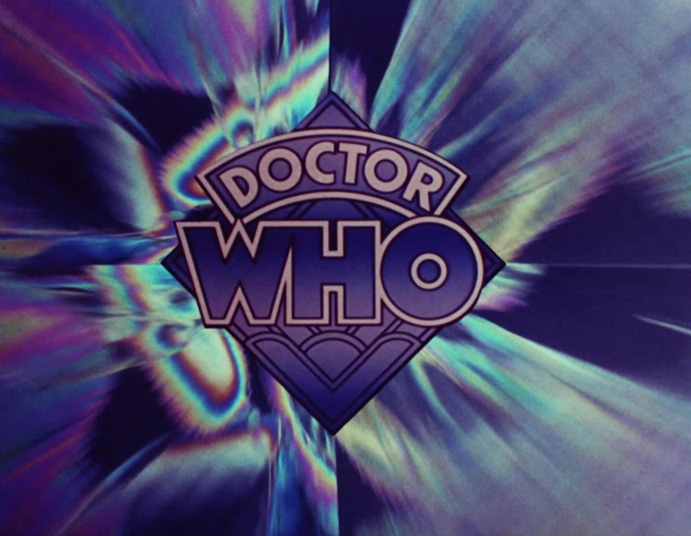
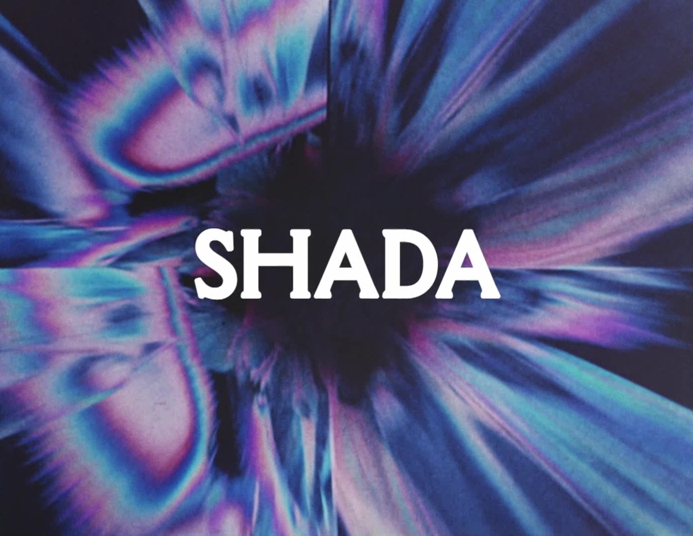
0:04:01 - Shada
• CHARLES NORTON:
Although, I've heard rumours of Shada having originally gone by another working title, there were no alternative titles on any of the paperwork we had access to in 2017. We had four drafts of the scripts pulled out of archive (dated from 1979 to 1992) and it's titled Shada on each of those scripts. Back in 1979, when they were first working on a serialised version of the story, they even got as far as compiling opening video captions for episodes 1, 2 and 3. And each one of those has got Shada down as the title too. So, if there ever was any intention to give the story a different title, it must have been dropped very early on. Despite all this however, Shada did later get a different working title during our time working on the production in 2017. Well, sort of. Long story this. So bear with me.
Whenever one of these productions is commissioned by BBC Studios (or BBC Worldwide, as it was then known), it is officially designated as Premium Content. That's not my term, but an internal BBC designation. What it basically means is that details of the production are meant to be kept as confidential as humanly possible until after post-production has completed, so as not to undermine any later promotional plans. All and any content generated by or in connection with the project has to be authorised by an executive before it can be released. At its most serious, it can sometimes even mean people having to sign a Non Disclosure Agreement before they join the project. Although that was not actually the case with Shada, there were other precautions. Footage was still sometimes watermarked before being shared outside of the crew, for instance. Most specifically, the content designation meant that we had to keep the window blinds drawn when we were in the edit-suite at TV Centre. And yes, that was an actual rule. We got told off by Edit Village on one occasion, for propping the door to the edit suite open with a chair, when one of us went to the toilet. It's all taken quite seriously. To put it all into context, it's perhaps worth keeping in mind that we were making Shada at the same time BBC Wales team were starting pre-production work on Jodie Whittaker's first season of Doctor Who. And they were working in the same building as us at one point. So, the heightened secrecy did have some sound logic behind it.
Anyway, what has any of this to do with the title of Shada? Well, as part of being designated Premium Content, you have to open up a folder on the BBC Studios shared-drive. This is where we upload most of our files, when working on the production. And this production folder needs to be given a name. However, it has to be a name that doesn't advertise what the production actually is. So as not to attract attention. So, when we were working on The Power of the Daleks in 2016, the production was internally only ever logged under the title: 'Blue Harvest'. And yes, that was us essentially being very silly. When we did Shada the following year, we still hadn't really grown up. And so we again code-named the production with a silly in-joke for cinema buffs. And that's how, throughout 2017, Shada was officially known within the BBC under the working title of: 'Genre'. That was its title - 'Genre'. I'll leave it to you to Google that one for yourself.
By the time The Macra Terror rolled round in 2018, I'm afraid the joke had gotten a bit out of hand and we were actually attracting more attention than we were deflecting. So on that occasion, we decided to take things a bit more seriously and come up with a title for our production folder so boring that nobody would ever express any interest in it at all, And so the working title for The Macra Terror became: 'Financial Year Ending'.
• MARK AYRES:
This all confused me terribly and I was constantly opening the wrong folder. I still am.
Although, I've heard rumours of Shada having originally gone by another working title, there were no alternative titles on any of the paperwork we had access to in 2017. We had four drafts of the scripts pulled out of archive (dated from 1979 to 1992) and it's titled Shada on each of those scripts. Back in 1979, when they were first working on a serialised version of the story, they even got as far as compiling opening video captions for episodes 1, 2 and 3. And each one of those has got Shada down as the title too. So, if there ever was any intention to give the story a different title, it must have been dropped very early on. Despite all this however, Shada did later get a different working title during our time working on the production in 2017. Well, sort of. Long story this. So bear with me.
Whenever one of these productions is commissioned by BBC Studios (or BBC Worldwide, as it was then known), it is officially designated as Premium Content. That's not my term, but an internal BBC designation. What it basically means is that details of the production are meant to be kept as confidential as humanly possible until after post-production has completed, so as not to undermine any later promotional plans. All and any content generated by or in connection with the project has to be authorised by an executive before it can be released. At its most serious, it can sometimes even mean people having to sign a Non Disclosure Agreement before they join the project. Although that was not actually the case with Shada, there were other precautions. Footage was still sometimes watermarked before being shared outside of the crew, for instance. Most specifically, the content designation meant that we had to keep the window blinds drawn when we were in the edit-suite at TV Centre. And yes, that was an actual rule. We got told off by Edit Village on one occasion, for propping the door to the edit suite open with a chair, when one of us went to the toilet. It's all taken quite seriously. To put it all into context, it's perhaps worth keeping in mind that we were making Shada at the same time BBC Wales team were starting pre-production work on Jodie Whittaker's first season of Doctor Who. And they were working in the same building as us at one point. So, the heightened secrecy did have some sound logic behind it.
Anyway, what has any of this to do with the title of Shada? Well, as part of being designated Premium Content, you have to open up a folder on the BBC Studios shared-drive. This is where we upload most of our files, when working on the production. And this production folder needs to be given a name. However, it has to be a name that doesn't advertise what the production actually is. So as not to attract attention. So, when we were working on The Power of the Daleks in 2016, the production was internally only ever logged under the title: 'Blue Harvest'. And yes, that was us essentially being very silly. When we did Shada the following year, we still hadn't really grown up. And so we again code-named the production with a silly in-joke for cinema buffs. And that's how, throughout 2017, Shada was officially known within the BBC under the working title of: 'Genre'. That was its title - 'Genre'. I'll leave it to you to Google that one for yourself.
By the time The Macra Terror rolled round in 2018, I'm afraid the joke had gotten a bit out of hand and we were actually attracting more attention than we were deflecting. So on that occasion, we decided to take things a bit more seriously and come up with a title for our production folder so boring that nobody would ever express any interest in it at all, And so the working title for The Macra Terror became: 'Financial Year Ending'.
• MARK AYRES:
This all confused me terribly and I was constantly opening the wrong folder. I still am.
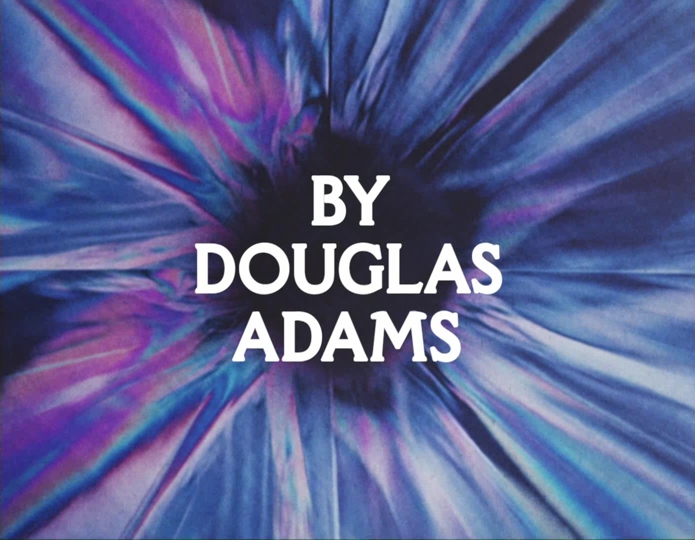
0:04:10 - Chris riding through Cambridge
• CHARLES NORTON:
This is the very first section of location footage in Shada, filmed midway through the production's very first day of filming on 15th October 1979. The location footage on Shada is interesting as they are the only bits of the production to have been truly completed (at least visually) back in 1979. Lots of 1979 scenes were also shot in the studio of course. However, none of the studio shot scenes were ever edited, at least not as part of the original production block in 1979. When we picked up the production in 2017, we had just over six hours worth of raw unedited footage from the four days of studio shooting they'd done in late 1979 at Ealing Studios and Television Centre. None of it in any way edited - just hours and hours of raw takes. One of my first jobs on Shada was to sit down with all that footage and create a rough cut of each scene. It took many weeks of work to just do that. However, the location filming was different.
Location filming on Shada concluded in Cambridge on 19th October 1979. Once it was complete, all the raw footage from that shoot went off to the Television Centre cutting rooms. And while the rest of the cast and crew worked downstairs shooting the studio scenes, film editor Tariq Anwar was left in the cutting room to complete all of the editing on those scenes that had earlier been shot on location. The paperwork doesn't make the exact dates clear. However, when production was suspended in December 1979, Tariq Anwar had already completed all of his editing on the location film. All of the outdoor scenes, basically. So, even though we had to do a lot of editing work on the studio scenes, we didn't have anywhere near as much work to do on the location scenes. We already had all the location footage fully edited into complete scenes, all ready to go. The first of these scenes being this one of Chris on his bicycle.
We spoke to Tariq during production and he was extremely helpful in explaining exactly how he'd worked on the footage back in the days - although he recalled little of the specific production itself. I think he later came to the National Film Theatre screening of Shada in December 2017.
• MARK AYRES:
An interesting thing about the location film is that it is not only edited, it is also dubbed (at least up until adding music and any additional voices such as K9). This was a BBC rule, and sometimes made it harder to match location footage to studio. But rules is rules.
• CHARLES NORTON:
Chris' location-filmed bicycle scene is also, of course, the first chance we get to hear a burst of Mark Ayres' glorious Cambridge theme, as Chris rides up to the front of St. Cedd's College. This (along with all the incidental music for this story) was newly composed by Mark in a style sympathetic to that of other 1970s Doctor Who episodes of this period. It's modelled specifically upon the style of composer Dudley Simpson, who scored the bulk of Tom Baker's episodes between 1974 and 1979. The music was recorded at Masterchord Studios in London on 25th and 26th October 2017. In November 2017, a few days before post-production was completed on Shada, we had news from Dudley Simpson's family in Australia that Simpson had died. We dedicated the final production to him, with a caption card added at the end of the programme.
• MARK AYRES:
Yes, the music was modelled as closely as possible on Dudley’s working methods at the time Shada was originally conceived. He would record a small chamber orchestra (a couple of horns, clarinet, cello or flute plus percussion) with piano/organ and synthesiser, then perhaps over-dub additional synthesisers later. For Shada, I recorded all the keyboards, synthesisers and flute myself, then we had three sessions with the live players: two horns, clarinet doubling bass clarinet, cello and percussion (timpani and marimba).
I wanted it to sound authentic to the period, and hopefully act as a logical bridge between The Horns of Nimon and The Leisure Hive. I even went as far as composing the entire score at 120bpm (or easy multiples or divisions of 120bpm) as that’s exactly what Dudley did for easy music-to-picture synchronisation in the days before time code and tempo maps.
A little aside: there had been a number of other proposals to complete Shada before Charles got his hands on it, and a few years previously the retired Dudley had expressed interest in providing thematic material for the story that I would develop. Sadly, Dudley was unable to contribute when it finally happened.
This is the very first section of location footage in Shada, filmed midway through the production's very first day of filming on 15th October 1979. The location footage on Shada is interesting as they are the only bits of the production to have been truly completed (at least visually) back in 1979. Lots of 1979 scenes were also shot in the studio of course. However, none of the studio shot scenes were ever edited, at least not as part of the original production block in 1979. When we picked up the production in 2017, we had just over six hours worth of raw unedited footage from the four days of studio shooting they'd done in late 1979 at Ealing Studios and Television Centre. None of it in any way edited - just hours and hours of raw takes. One of my first jobs on Shada was to sit down with all that footage and create a rough cut of each scene. It took many weeks of work to just do that. However, the location filming was different.
Location filming on Shada concluded in Cambridge on 19th October 1979. Once it was complete, all the raw footage from that shoot went off to the Television Centre cutting rooms. And while the rest of the cast and crew worked downstairs shooting the studio scenes, film editor Tariq Anwar was left in the cutting room to complete all of the editing on those scenes that had earlier been shot on location. The paperwork doesn't make the exact dates clear. However, when production was suspended in December 1979, Tariq Anwar had already completed all of his editing on the location film. All of the outdoor scenes, basically. So, even though we had to do a lot of editing work on the studio scenes, we didn't have anywhere near as much work to do on the location scenes. We already had all the location footage fully edited into complete scenes, all ready to go. The first of these scenes being this one of Chris on his bicycle.
We spoke to Tariq during production and he was extremely helpful in explaining exactly how he'd worked on the footage back in the days - although he recalled little of the specific production itself. I think he later came to the National Film Theatre screening of Shada in December 2017.
• MARK AYRES:
An interesting thing about the location film is that it is not only edited, it is also dubbed (at least up until adding music and any additional voices such as K9). This was a BBC rule, and sometimes made it harder to match location footage to studio. But rules is rules.
• CHARLES NORTON:
Chris' location-filmed bicycle scene is also, of course, the first chance we get to hear a burst of Mark Ayres' glorious Cambridge theme, as Chris rides up to the front of St. Cedd's College. This (along with all the incidental music for this story) was newly composed by Mark in a style sympathetic to that of other 1970s Doctor Who episodes of this period. It's modelled specifically upon the style of composer Dudley Simpson, who scored the bulk of Tom Baker's episodes between 1974 and 1979. The music was recorded at Masterchord Studios in London on 25th and 26th October 2017. In November 2017, a few days before post-production was completed on Shada, we had news from Dudley Simpson's family in Australia that Simpson had died. We dedicated the final production to him, with a caption card added at the end of the programme.
• MARK AYRES:
Yes, the music was modelled as closely as possible on Dudley’s working methods at the time Shada was originally conceived. He would record a small chamber orchestra (a couple of horns, clarinet, cello or flute plus percussion) with piano/organ and synthesiser, then perhaps over-dub additional synthesisers later. For Shada, I recorded all the keyboards, synthesisers and flute myself, then we had three sessions with the live players: two horns, clarinet doubling bass clarinet, cello and percussion (timpani and marimba).
I wanted it to sound authentic to the period, and hopefully act as a logical bridge between The Horns of Nimon and The Leisure Hive. I even went as far as composing the entire score at 120bpm (or easy multiples or divisions of 120bpm) as that’s exactly what Dudley did for easy music-to-picture synchronisation in the days before time code and tempo maps.
A little aside: there had been a number of other proposals to complete Shada before Charles got his hands on it, and a few years previously the retired Dudley had expressed interest in providing thematic material for the story that I would develop. Sadly, Dudley was unable to contribute when it finally happened.
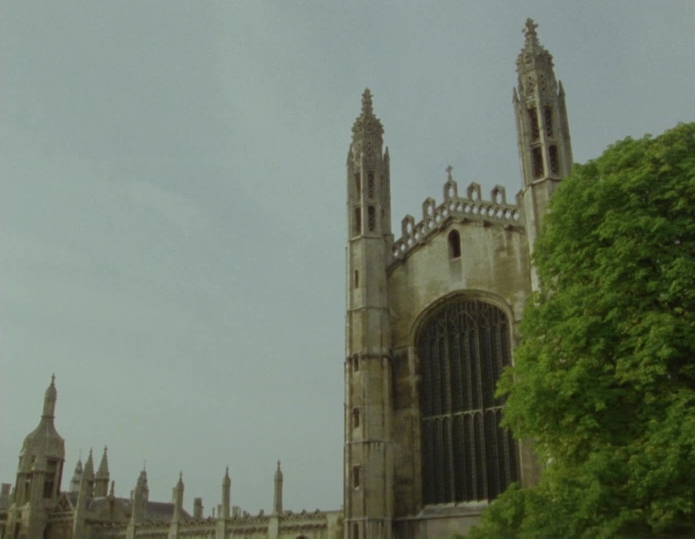
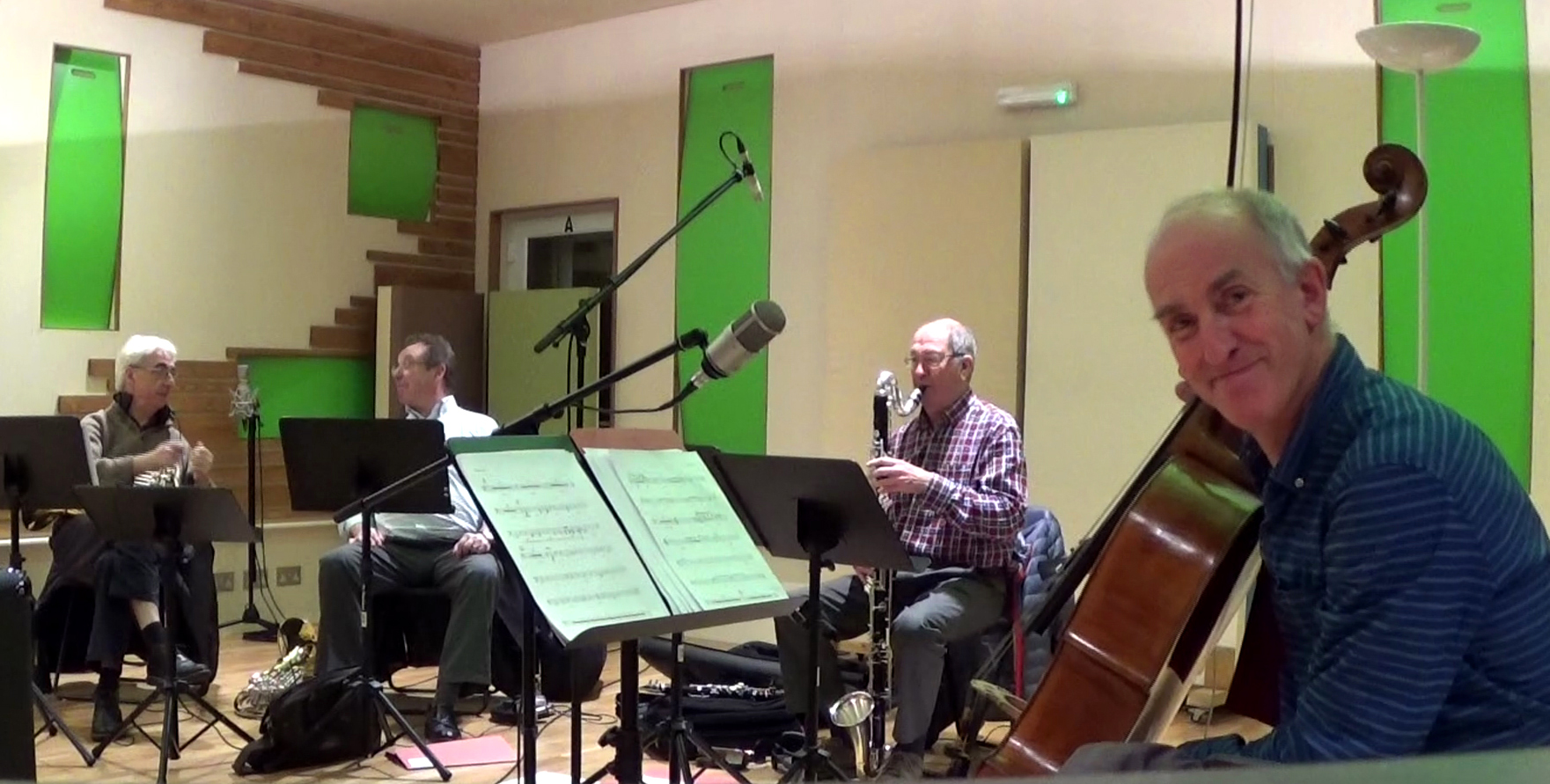
Session musicians at Masterchord Studios, London on 25th October 2017 (Image © Charles Norton)
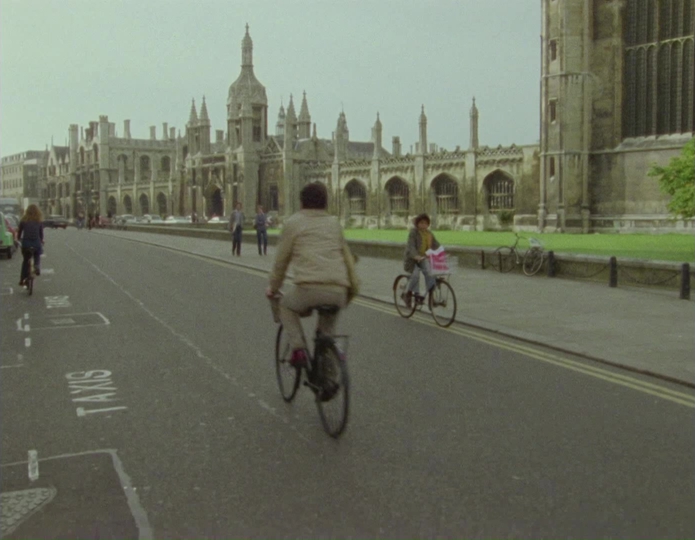
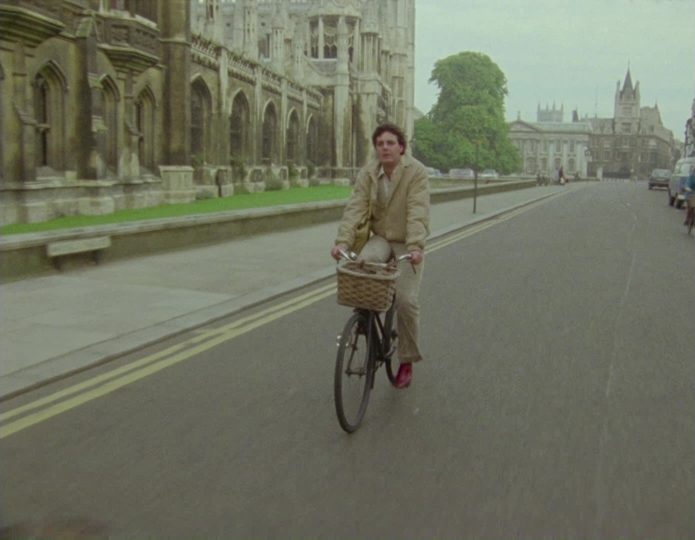
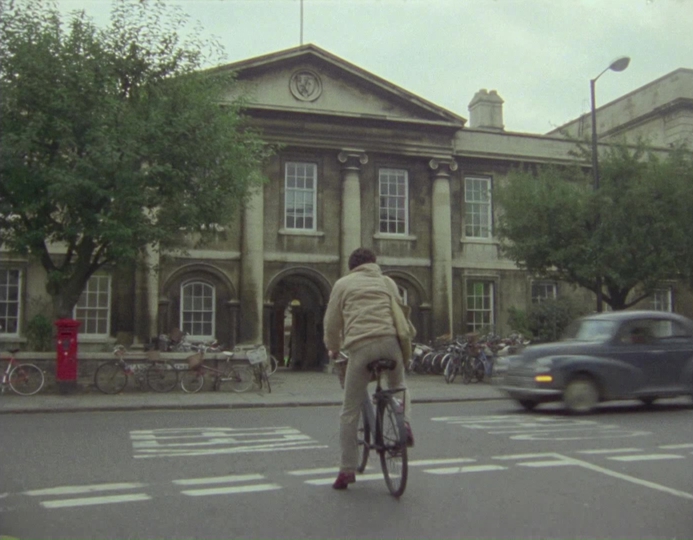
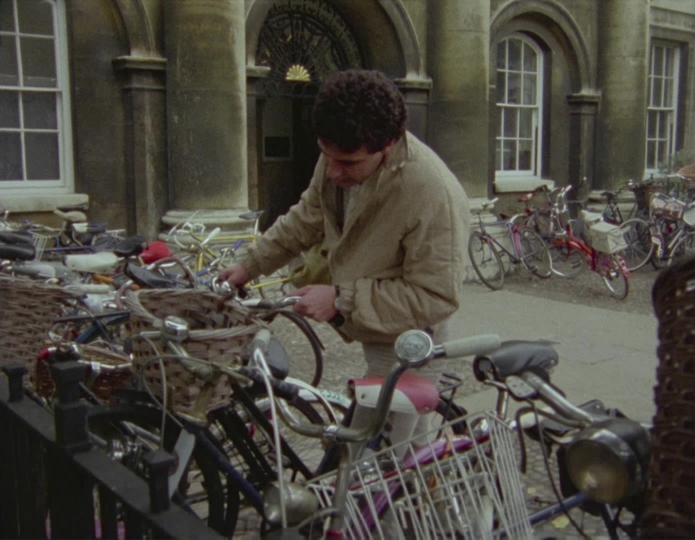
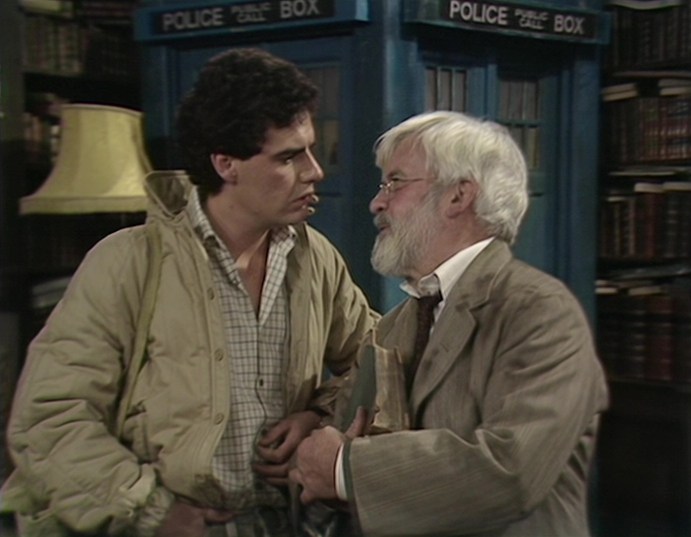
0:06:49 - Not getting run over by a coach and pair
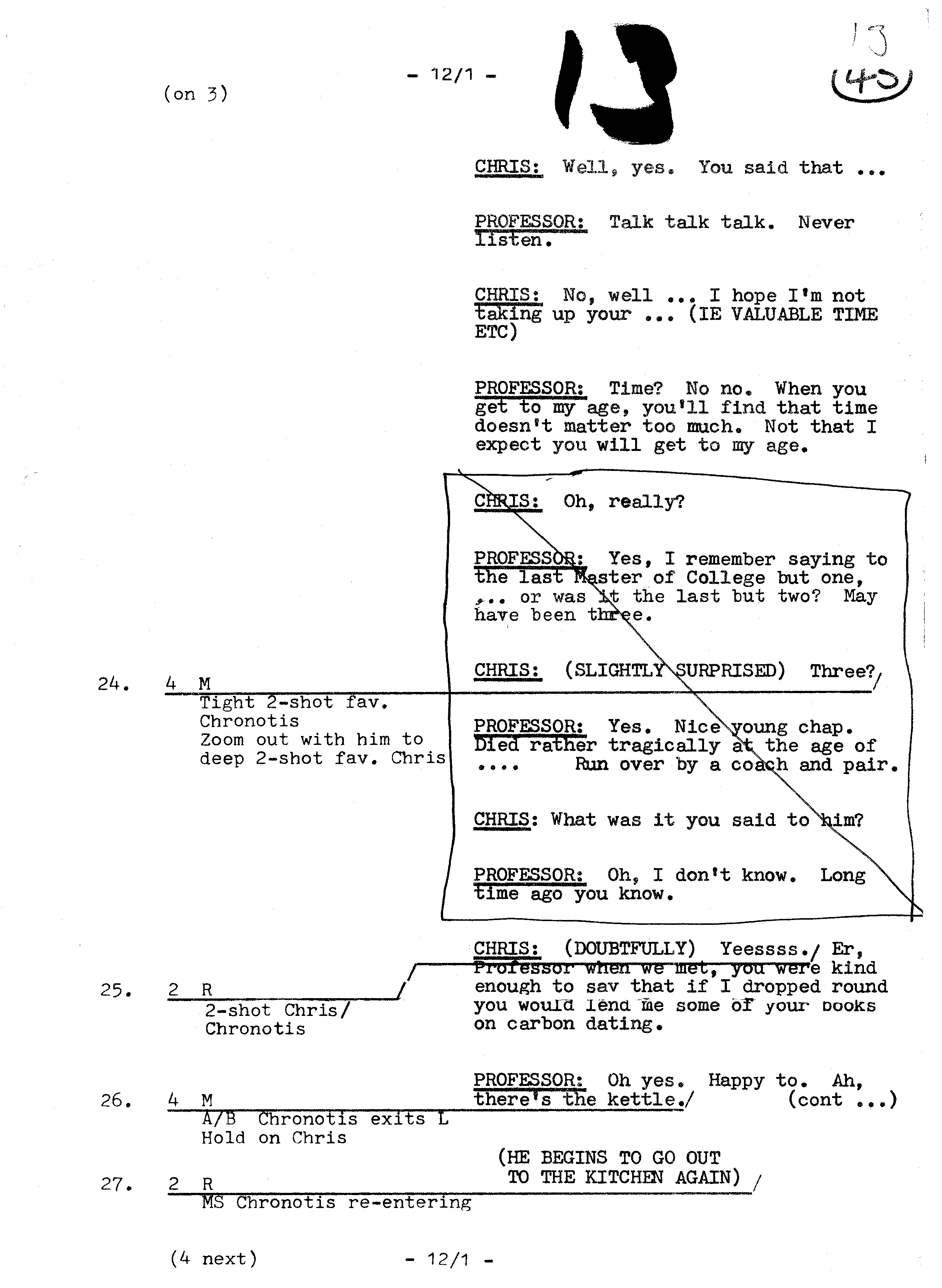
• CHARLES NORTON:
Back in 1979, the BBC originally scheduled for Shada to be broadcast across 6 x 25-minute instalments at the end of Doctor Who's 17th season. Of course, when production ground to a halt in late 1979, all plans to have Shada in Season 17, had to be abandoned. However, a few months later, the project was reviewed and it was decided that production on Shada might resume in 1980, with the story instead broadcast as part of Doctor Who's 18th season in 1981. This would have seen the story transmitted across 4 x 25 minute instalments. The camera scripts and director's notes for the originally suggested six-part version of Shada were never completed. So, we don't entirely know how that version of the story would have been assembled - what material would have been left in the final edit and what material left out. However, we do have a full script for the four-part 1981 version of Shada and the director's notes on that script are much more comprehensive than on the unfinished six-part script. So, we have a pretty good idea how the four-part version would have cut together.
Looking at this four-part script is very interesting, as it clearly indicates the production team's intention to delete a lot of footage from Shada that had already been shot. Large swathes of material (shot in 1979) would have been left on the cutting room floor, had the 1981 transmission gone ahead as planned. One of the first major cuts comes at 06'49" (timings taken from our 2017 edit, of course). As originally scripted (and as originally shot in 1979), Chronotis talks about an old Master of College being killed by a coach and pair. However, notes on the 1981 scripts for Shada indicate that a lot of the footage that had been shot for this part of the conversation in 1979 was to be removed for the final edit. The entire section from 06'49" to 07'09" would have been cut. And no, I have no idea how they'd have made that edit work either. They clearly meant to though.
When it came to us completing Shada in 2017, we largely ignored the editing notes that we had from 1979 to 1981. We were working to a very different brief. And things that the original production team might have felt didn't fit well within the context of an episodic format, might well have been things that we felt worked quite comfortably within the context of the feature-length TV-movie we were making. As a consequence of this, there's quite a lot material in the final 2017 edit of Shada, that any original 1979/1981 audience probably wouldn't have gotten to see, including this section with Chris and Chronotis talking about the coach and pair. This wasn't a matter of us just wilfully ignoring the production team's original artistic intent. It was more just a case of us now working on the production in a very different context and format to the one they were working in back in the 70s and 80s.
• MARK AYRES:
When preparing the six-part version in 2021, I did an experimental four-part edit based on the notes that Charles refers to. I couldn't get it down to less the 30 minutes per episode, not least because some of the suggested edits are - as Charles hints above - impossible. They shot complete scenes with multiple cameras and did not shoot any “cover”.
• CHARLES NORTON:
Mark's realisation of the abandoned four-part Shada is really rather good, by the way - complete with Sutton and Howell title sequences and credits. Sadly, it hasn't made it into the Season 17 Collection boxset. Disc space was too tight. Maybe it will see the light of day in some other form in the future. I hope so.
Back in 1979, the BBC originally scheduled for Shada to be broadcast across 6 x 25-minute instalments at the end of Doctor Who's 17th season. Of course, when production ground to a halt in late 1979, all plans to have Shada in Season 17, had to be abandoned. However, a few months later, the project was reviewed and it was decided that production on Shada might resume in 1980, with the story instead broadcast as part of Doctor Who's 18th season in 1981. This would have seen the story transmitted across 4 x 25 minute instalments. The camera scripts and director's notes for the originally suggested six-part version of Shada were never completed. So, we don't entirely know how that version of the story would have been assembled - what material would have been left in the final edit and what material left out. However, we do have a full script for the four-part 1981 version of Shada and the director's notes on that script are much more comprehensive than on the unfinished six-part script. So, we have a pretty good idea how the four-part version would have cut together.
Looking at this four-part script is very interesting, as it clearly indicates the production team's intention to delete a lot of footage from Shada that had already been shot. Large swathes of material (shot in 1979) would have been left on the cutting room floor, had the 1981 transmission gone ahead as planned. One of the first major cuts comes at 06'49" (timings taken from our 2017 edit, of course). As originally scripted (and as originally shot in 1979), Chronotis talks about an old Master of College being killed by a coach and pair. However, notes on the 1981 scripts for Shada indicate that a lot of the footage that had been shot for this part of the conversation in 1979 was to be removed for the final edit. The entire section from 06'49" to 07'09" would have been cut. And no, I have no idea how they'd have made that edit work either. They clearly meant to though.
When it came to us completing Shada in 2017, we largely ignored the editing notes that we had from 1979 to 1981. We were working to a very different brief. And things that the original production team might have felt didn't fit well within the context of an episodic format, might well have been things that we felt worked quite comfortably within the context of the feature-length TV-movie we were making. As a consequence of this, there's quite a lot material in the final 2017 edit of Shada, that any original 1979/1981 audience probably wouldn't have gotten to see, including this section with Chris and Chronotis talking about the coach and pair. This wasn't a matter of us just wilfully ignoring the production team's original artistic intent. It was more just a case of us now working on the production in a very different context and format to the one they were working in back in the 70s and 80s.
• MARK AYRES:
When preparing the six-part version in 2021, I did an experimental four-part edit based on the notes that Charles refers to. I couldn't get it down to less the 30 minutes per episode, not least because some of the suggested edits are - as Charles hints above - impossible. They shot complete scenes with multiple cameras and did not shoot any “cover”.
• CHARLES NORTON:
Mark's realisation of the abandoned four-part Shada is really rather good, by the way - complete with Sutton and Howell title sequences and credits. Sadly, it hasn't made it into the Season 17 Collection boxset. Disc space was too tight. Maybe it will see the light of day in some other form in the future. I hope so.
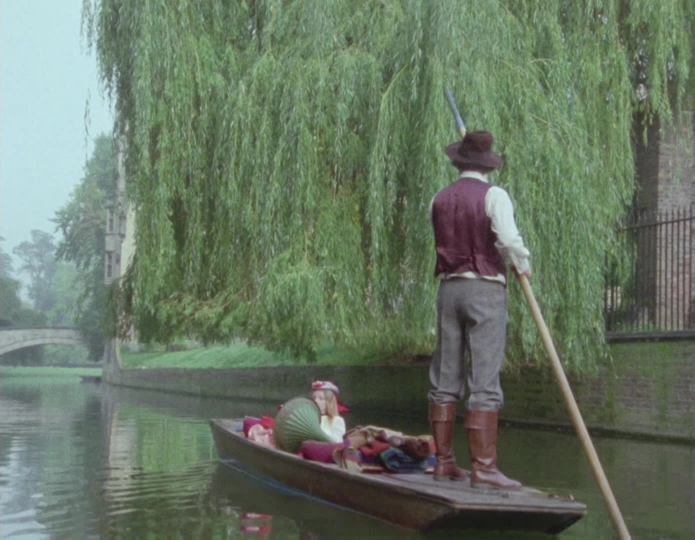
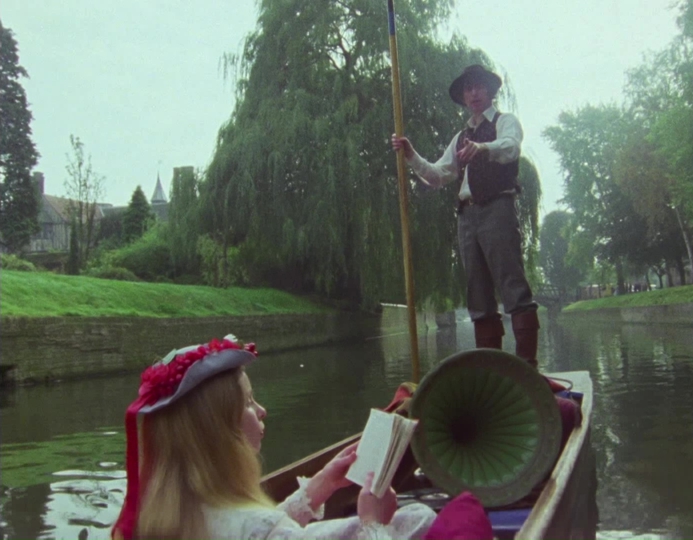
0:08:52 - The Doctor and Romana punting on the river (Film)
• CHARLES NORTON:
This scene on the river was the first thing ever shot for Shada. Filmed at the start of the very first shooting day on the morning of 15th October, 1979. Probably at about 11AM. For many years this was also the only scene from Shada most people ever had a chance to see. In 1983, the footage of Tom and Lalla on the river was incorporated into the 20th anniversary Doctor Who TV special, The Five Doctors, which I suppose also makes it the very first scene filmed for The Five Doctors too.
When we called up the original camera negatives of the Shada location filming, this boating scene surprisingly wasn't there. In fact, upon inspection, we discovered that three sections of footage were missing from the film negatives. Material that we knew had been shot and edited back in 1979, but which was mysteriously now absent from the negatives.
The first missing section of the Doctor and Romana on the river actually turned out to be relatively straightforward. What appears to have happened is that when the footage was edited into The Five Doctors in 1983, it had been physically cut and removed from the master negatives of Shada and spliced into the master negatives for The Five Doctors. Happily, all of the master negatives of The Five Doctors still existed in the archives. And so, in order to get all the footage that we needed, we simply had the first few rolls of The Five Doctors master negatives scanned in alongside all our Shada negatives (all this work was again done at the R3Store facilities house in Poplar on 29th August 2017). This gave us a good quality transfer of the full punting scene. However, there were still two other sections of footage missing from the Shada negatives, of which more later...
This scene on the river was the first thing ever shot for Shada. Filmed at the start of the very first shooting day on the morning of 15th October, 1979. Probably at about 11AM. For many years this was also the only scene from Shada most people ever had a chance to see. In 1983, the footage of Tom and Lalla on the river was incorporated into the 20th anniversary Doctor Who TV special, The Five Doctors, which I suppose also makes it the very first scene filmed for The Five Doctors too.
When we called up the original camera negatives of the Shada location filming, this boating scene surprisingly wasn't there. In fact, upon inspection, we discovered that three sections of footage were missing from the film negatives. Material that we knew had been shot and edited back in 1979, but which was mysteriously now absent from the negatives.
The first missing section of the Doctor and Romana on the river actually turned out to be relatively straightforward. What appears to have happened is that when the footage was edited into The Five Doctors in 1983, it had been physically cut and removed from the master negatives of Shada and spliced into the master negatives for The Five Doctors. Happily, all of the master negatives of The Five Doctors still existed in the archives. And so, in order to get all the footage that we needed, we simply had the first few rolls of The Five Doctors master negatives scanned in alongside all our Shada negatives (all this work was again done at the R3Store facilities house in Poplar on 29th August 2017). This gave us a good quality transfer of the full punting scene. However, there were still two other sections of footage missing from the Shada negatives, of which more later...
• CHARLES NORTON:
In Douglas Adams' original script, he specifically states that the song we hear during this scene should be 'Jolly Boating Weather' (a traditional 19th century school song also known as 'The Eaton Boating Song'.). Director Pennant Roberts did not record any music during the filming day on location in October 1979. And so it appears that he intended that any music would be dubbed over the scene in post-production. This would have been done during a studio gallery session - originally planned to take place in December 1979 at BBC Television Centre. Of course, following the suspension of all production on Shada in November 1979, that planned dub never took place.
When the footage of this scene was finally used as part of The Five Doctors in 1983, the music that the then production team dubbed onto the scene wasn't 'Jolly Boating Weather', but a completely different library track altogether. Later, when a compilation of all the surviving Shada footage was released by BBC Video in 1992, yet another unrelated library track was played and when a new edit of The Five Doctors was released on BBC Video in 1995, again 'Jolly Boating Weather' was overlooked and another slightly different piece of library music was dubbed onto the scene.
Never on any of these occasions, was 'Jolly Boating Weather' actually played alongside this scene, as originally intended. So, when it came for us to complete Shada in 2017, it gave us one final opportunity to at last dub the 'correct' piece of music onto this scene for the very first time. Just as Douglas Adams had first considered back in 1979. We used a 1923 HMV recording of the song (courtesy of the British Library Sound Archive), which fitted with the period 78 RPM gramophone you see in the scene. It also (we felt) fitted the tone and atmosphere of the scene rather better than all the many unrelated stock tracks that had previously accompanied this scene over the years.
In Douglas Adams' original script, he specifically states that the song we hear during this scene should be 'Jolly Boating Weather' (a traditional 19th century school song also known as 'The Eaton Boating Song'.). Director Pennant Roberts did not record any music during the filming day on location in October 1979. And so it appears that he intended that any music would be dubbed over the scene in post-production. This would have been done during a studio gallery session - originally planned to take place in December 1979 at BBC Television Centre. Of course, following the suspension of all production on Shada in November 1979, that planned dub never took place.
When the footage of this scene was finally used as part of The Five Doctors in 1983, the music that the then production team dubbed onto the scene wasn't 'Jolly Boating Weather', but a completely different library track altogether. Later, when a compilation of all the surviving Shada footage was released by BBC Video in 1992, yet another unrelated library track was played and when a new edit of The Five Doctors was released on BBC Video in 1995, again 'Jolly Boating Weather' was overlooked and another slightly different piece of library music was dubbed onto the scene.
Never on any of these occasions, was 'Jolly Boating Weather' actually played alongside this scene, as originally intended. So, when it came for us to complete Shada in 2017, it gave us one final opportunity to at last dub the 'correct' piece of music onto this scene for the very first time. Just as Douglas Adams had first considered back in 1979. We used a 1923 HMV recording of the song (courtesy of the British Library Sound Archive), which fitted with the period 78 RPM gramophone you see in the scene. It also (we felt) fitted the tone and atmosphere of the scene rather better than all the many unrelated stock tracks that had previously accompanied this scene over the years.
0:11:00 - The Doctor and Romana paddle away as the camera pans up.
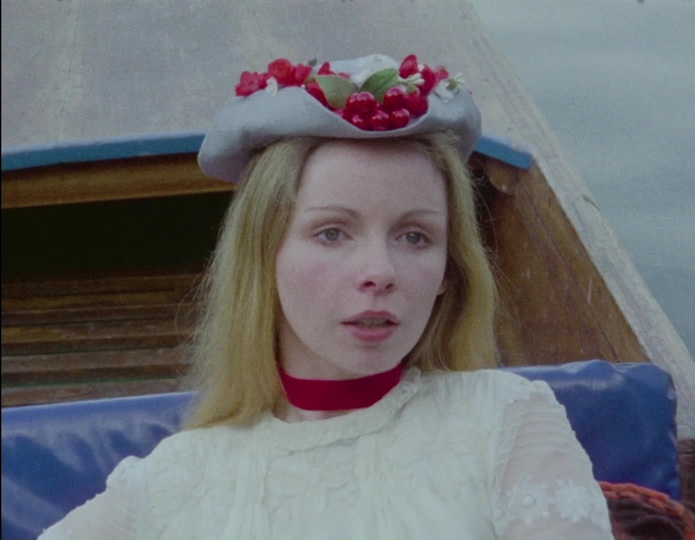
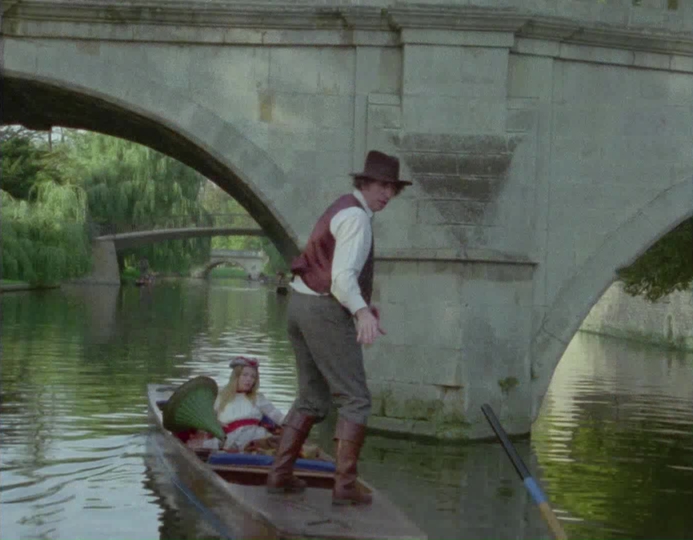
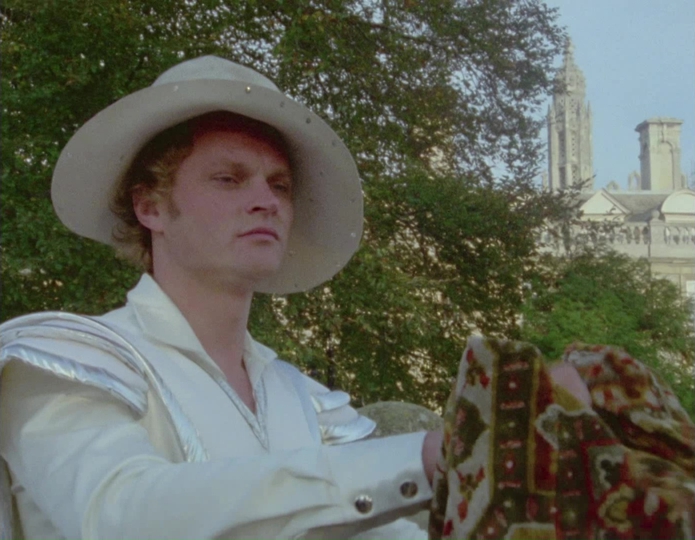
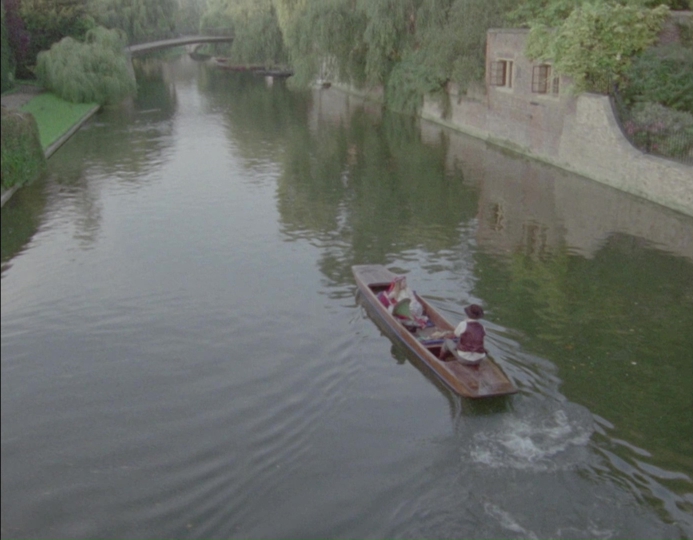
• CHARLES NORTON:
That camera pan wasn't there in the footage as shot in 1979. The shot, as filmed in October 1979, ends a good ten seconds or so earlier than you see in the final 2017 edit. All the stuff of the camera panning up and Tom paddling away has been digitally 'faked' by Rob Ritchie (our compositor). He took the last few frames of the 'real' 1979 footage and found a way of manipulating them in such a way as to create the impression of a longer continuous shot. We then mixed to an 2D sky (painted by background artist Colin Howard) as we clear the tops of the trees. As it was our very first transition into animation, I hoped it might be a good way to ease us out of one medium and into another.
That camera pan wasn't there in the footage as shot in 1979. The shot, as filmed in October 1979, ends a good ten seconds or so earlier than you see in the final 2017 edit. All the stuff of the camera panning up and Tom paddling away has been digitally 'faked' by Rob Ritchie (our compositor). He took the last few frames of the 'real' 1979 footage and found a way of manipulating them in such a way as to create the impression of a longer continuous shot. We then mixed to an 2D sky (painted by background artist Colin Howard) as we clear the tops of the trees. As it was our very first transition into animation, I hoped it might be a good way to ease us out of one medium and into another.
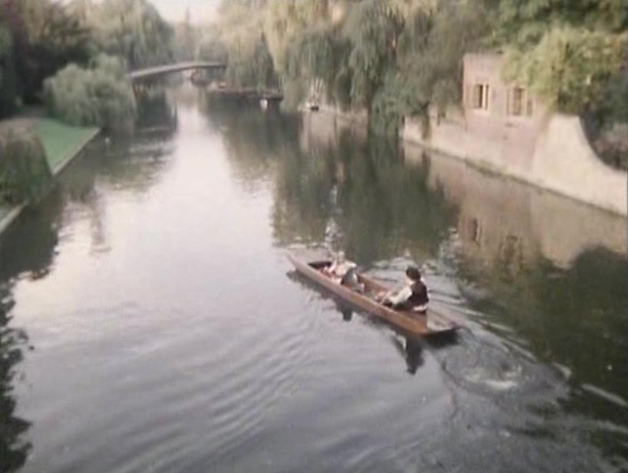
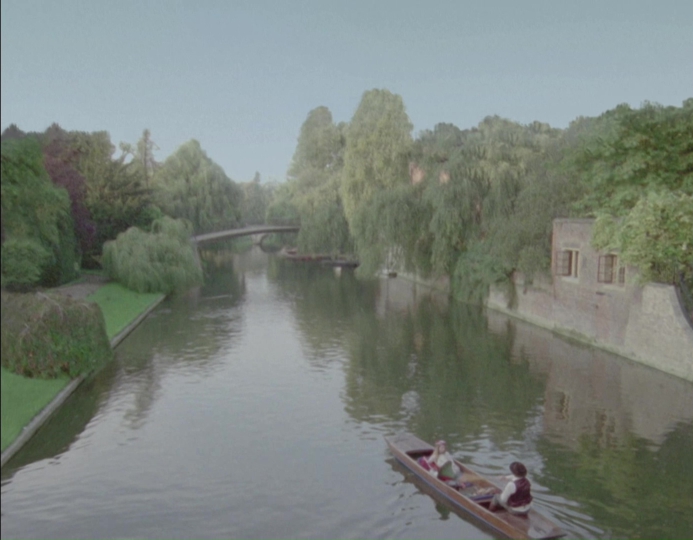
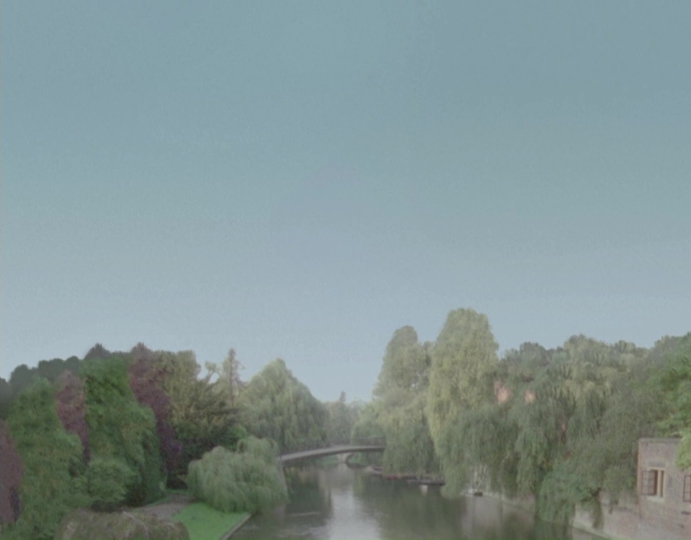
Looking back now, I suspect it might have been a tiny bit too ambitious for our resources. However, I think we largely still get away with it. And it's an excellent bit of work from Rob, working with very little real-world footage and stretching it quite significantly in a direction it was never designed to be stretched originally.
For comparison, this is the final frame of the original sequence.
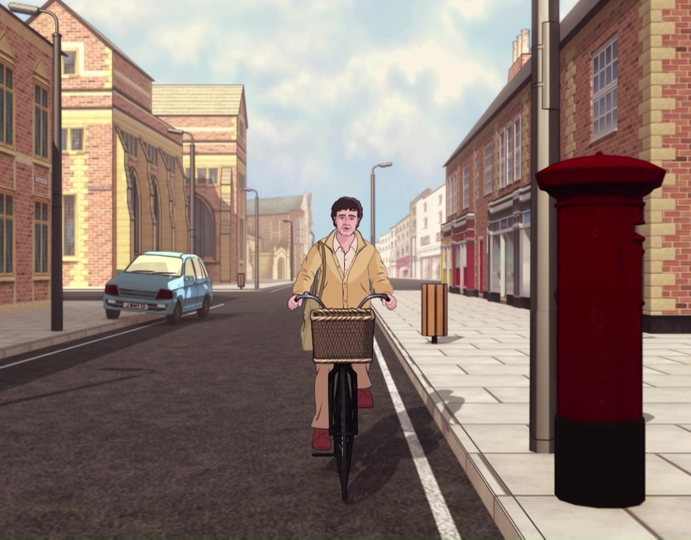
• CHARLES NORTON:
By an awfully long way this is probably the most complex animation shot in the entire production. It is also the first piece of animation the viewer sees when they watch the finished feature. I felt it was important to try and make it as visually immersive as possible - as we try to pull the audience down into this very different world. The scene is a key bridge between the two modes of production. It was always going to be one that we spent a lot of time trying to get right. Incidentally, the scene isn't actually in any of original 1979 scripts for Shada. It's a new invention of ours that we dreamt up in 2017, put in purely for the purpose of helping ease the audience into the new medium.
All the buildings, the road and the sky are traditionally hand-painted elements from one of our background artists (Colin Howard). However, they've been mapped over a 3D CG wire-frame model of the environment, built in the computer by compositor Rob Ritchie. The camera move and the bicycle riding along the road were all then animated digitally by Rob, within that 3D environment, with hand-painted elements from Colin later mapped onto the bicycle. The animation was then rendered off in rough form as a series of around 800 individual still frames, showing the empty bicycle riding itself through the shot, as the camera moves around it. Our character artist (Martin Geraghty) then took seven key frames from across this sequence of frames and drew a headless Chris in over the top of the bicycle in the correct perspective and proportions. This was done in pencil.
The pencil drawings of these seven key frames (of Chris on the bike) were sent to animator Barry Baker (together with a full set of turnaround drawings of Chris' head and body drawn from every possible angle that he might need). Barry then sketched in the missing frames of Chris on the bike that came in between (and around) the seven frames Martin had already drew. When he had roughed in all 800 frames, he then tidied them all up on a second pass. This was done with the background of the bicycle on a layer underneath the drawing of Chris. The head was then done in the same way on yet another top layer. For the head, Barry used an animation program called Moho, to speed the process up. When Barry had finished, we had a sequence of 800 frames of Chris floating through the air riding past the camera on an invisible bicycle. And we also had a sequence of 800 frames of the bicycle riding itself without Chris. The two were combined by Rob into a sequence of bicycle and Chris together. These frames were then further cleaned up by Martin Geraghty, who went in and redrew a few parts of Chris' head and face in certain frames, where the Moho program had forced the character off-model a bit. The final frames could then be composited (by Rob) into the background animation of the street, which Rob and Colin had been independently working on finalising in the meantime.
The original plan was to also add in a few more elements to the street scene, such as people on the pavement and cars going past. It was hoped we could animate the sunshine pouring down a bit more too. However, as is often the case, time was against us and we eventually had to find a point in the process where we could stop and move onto the next scene. Otherwise we'd probably still be playing with it now.
• MARK AYRES:
Of course, in 2021, we played with it some more, and Rob has indeed added some more elements to this scene and it has been re-lit and re-graded for the Season 17 Collection.
By an awfully long way this is probably the most complex animation shot in the entire production. It is also the first piece of animation the viewer sees when they watch the finished feature. I felt it was important to try and make it as visually immersive as possible - as we try to pull the audience down into this very different world. The scene is a key bridge between the two modes of production. It was always going to be one that we spent a lot of time trying to get right. Incidentally, the scene isn't actually in any of original 1979 scripts for Shada. It's a new invention of ours that we dreamt up in 2017, put in purely for the purpose of helping ease the audience into the new medium.
All the buildings, the road and the sky are traditionally hand-painted elements from one of our background artists (Colin Howard). However, they've been mapped over a 3D CG wire-frame model of the environment, built in the computer by compositor Rob Ritchie. The camera move and the bicycle riding along the road were all then animated digitally by Rob, within that 3D environment, with hand-painted elements from Colin later mapped onto the bicycle. The animation was then rendered off in rough form as a series of around 800 individual still frames, showing the empty bicycle riding itself through the shot, as the camera moves around it. Our character artist (Martin Geraghty) then took seven key frames from across this sequence of frames and drew a headless Chris in over the top of the bicycle in the correct perspective and proportions. This was done in pencil.
The pencil drawings of these seven key frames (of Chris on the bike) were sent to animator Barry Baker (together with a full set of turnaround drawings of Chris' head and body drawn from every possible angle that he might need). Barry then sketched in the missing frames of Chris on the bike that came in between (and around) the seven frames Martin had already drew. When he had roughed in all 800 frames, he then tidied them all up on a second pass. This was done with the background of the bicycle on a layer underneath the drawing of Chris. The head was then done in the same way on yet another top layer. For the head, Barry used an animation program called Moho, to speed the process up. When Barry had finished, we had a sequence of 800 frames of Chris floating through the air riding past the camera on an invisible bicycle. And we also had a sequence of 800 frames of the bicycle riding itself without Chris. The two were combined by Rob into a sequence of bicycle and Chris together. These frames were then further cleaned up by Martin Geraghty, who went in and redrew a few parts of Chris' head and face in certain frames, where the Moho program had forced the character off-model a bit. The final frames could then be composited (by Rob) into the background animation of the street, which Rob and Colin had been independently working on finalising in the meantime.
The original plan was to also add in a few more elements to the street scene, such as people on the pavement and cars going past. It was hoped we could animate the sunshine pouring down a bit more too. However, as is often the case, time was against us and we eventually had to find a point in the process where we could stop and move onto the next scene. Otherwise we'd probably still be playing with it now.
• MARK AYRES:
Of course, in 2021, we played with it some more, and Rob has indeed added some more elements to this scene and it has been re-lit and re-graded for the Season 17 Collection.
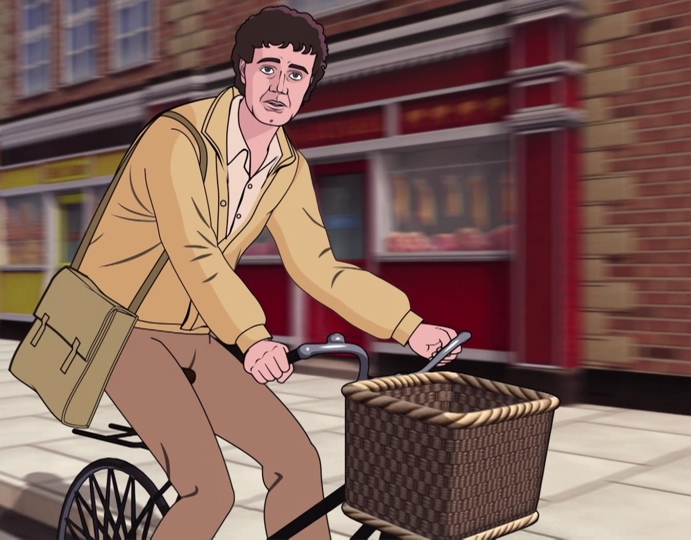
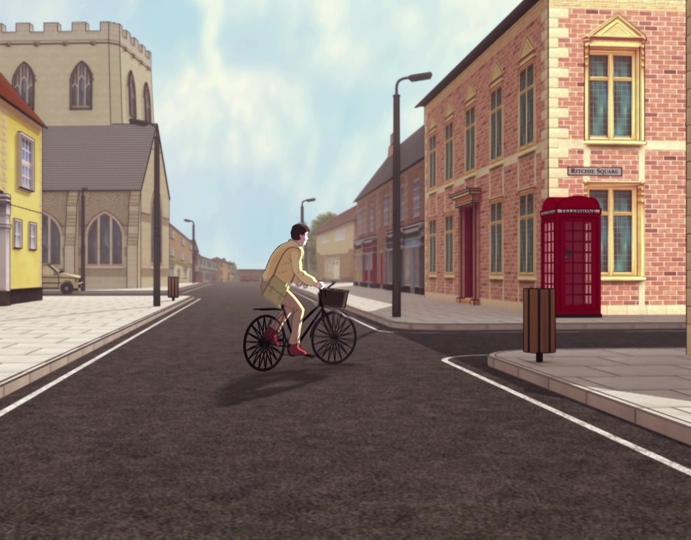
• CHARLES NORTON:
Incidentally, it really is blink and you'll miss it. However, there's some lovely detail touches on the buildings that Colin Howard painted for us in this shot. All the shop-fronts have had a lot of work put into them with some familiar Doctor Who names. There's a branch of 'Bellal's Bakery'. There's a butchers called 'S. Eye Butcher'. The sweet-shop is called 'The Kandyman'. And the toyshop is called 'The Celestial Toyroom'. Toys on display in the window include some of the soldiers from The Mind Robber, a Mr. Sin puppet and a miniature Chumbley. Sadly, the toy soldier is about the only thing you can make out clearly under the motion blur as Chris rides by.
Incidentally, it really is blink and you'll miss it. However, there's some lovely detail touches on the buildings that Colin Howard painted for us in this shot. All the shop-fronts have had a lot of work put into them with some familiar Doctor Who names. There's a branch of 'Bellal's Bakery'. There's a butchers called 'S. Eye Butcher'. The sweet-shop is called 'The Kandyman'. And the toyshop is called 'The Celestial Toyroom'. Toys on display in the window include some of the soldiers from The Mind Robber, a Mr. Sin puppet and a miniature Chumbley. Sadly, the toy soldier is about the only thing you can make out clearly under the motion blur as Chris rides by.
The more populated version of the opening animation scene from the Doctor Who Season 17 Collection Blu-ray boxset
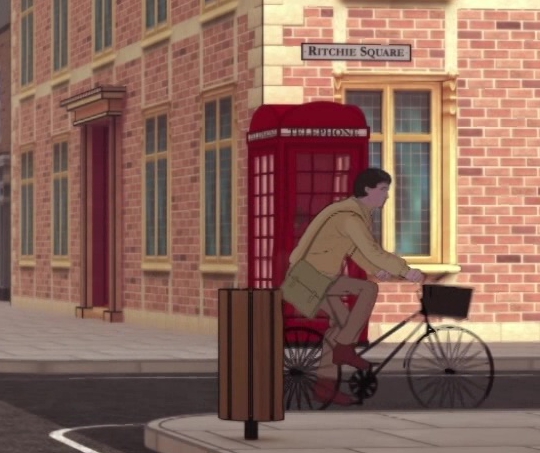
Chris turns into Ritchie Square, named after compositor, Rob Ritchie
0:00:02 - Opening Continuity Announcement
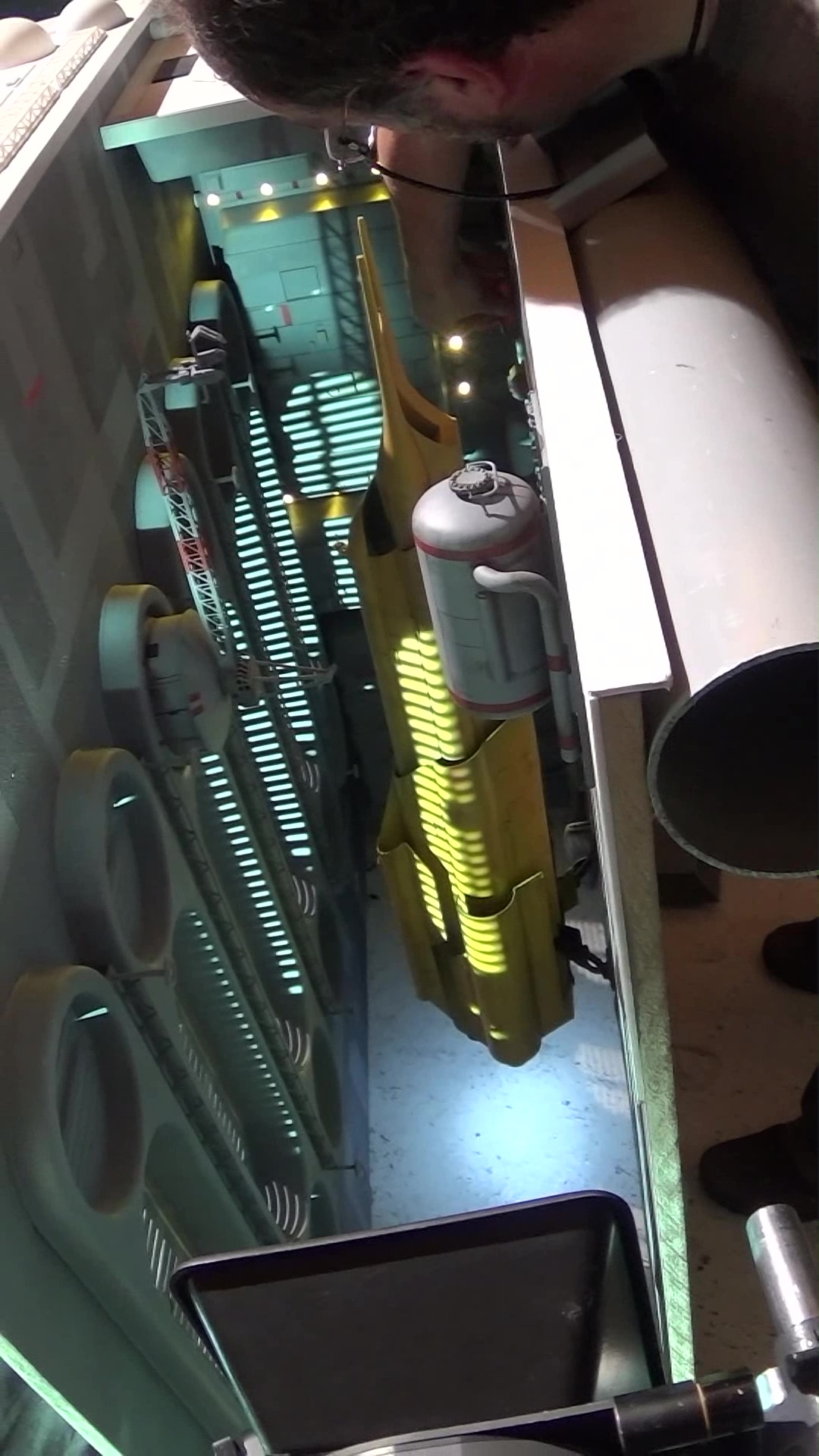
0:08:52 - The Doctor and Romana punting on the river (Sound)
0:11:20 - Chris rides his bicycle back to the lab
Mike Tucker and Nick Kool working on the
launch of Skagra's ship from the Think Tank
launch of Skagra's ship from the Think Tank
















